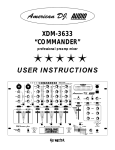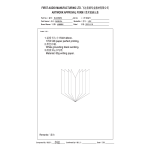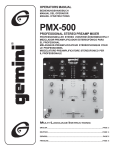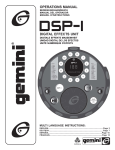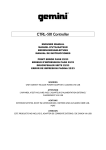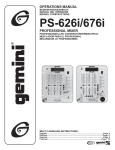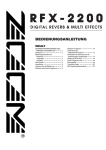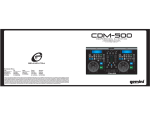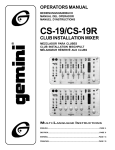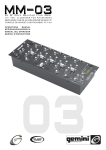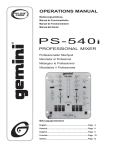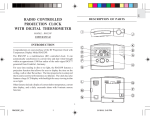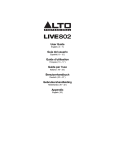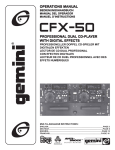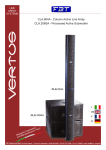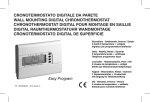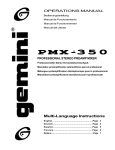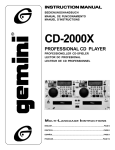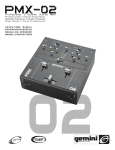Download fx-7000 10
Transcript
OPERATIONS MANUAL BEDIENUNGSHANDBUCH MANUAL DEL OPERADOR MANUEL D’INSTRUCTIONS FX-7000 10 “PRO STEREO MIXER WITH DSP EFFECTS PRO STEREO MISCHPULT MIT DSP-EFFEKTEN MEZCLADOR PRO STEREO CON EFECTOS DSP MELANGEUR STEREOPHONIQUE PROFESSIONNEL AVEC EFFETS DSP MULTI-LANGUAGE INSTRUCTIONS: ENGLISH.................................................................................................PAGE 2 DEUTSCH................................................................................................PAGE 7 ESPAÑOL..............................................................................................PAGE 10 FRANCAIS.............................................................................................PAGE 13 (1) QUICK START GUIDE: 1 2 3 4 5 6 7 8 9 10 11 12 13 14 15 16 17 18 19 20 21 22 23 24 25 26 27 28 29 30 31 32 33 34 35 36 37 38 39 40 41 42 43 44 45 46 47 48 49 50 51 52 53 54 55 56 57 AC 15V: Use this input to connect the power, plug the adapter into an outlet and the AC 15V (1) input. POWER: To turn on the POWER (2), press this switch once. BALANCED OUTPUT: Use the BALANCED OUTPUT (3) to connect to your amplifiers BALANCED input. MASTER OUTPUT: An unbalanced output to connect to your amplifiers input. ZONE OUTPUT: Connect this line to an additional amplifier or powered speakers. REC OUTPUT: To record a mix, connect this line to a recording device. SEND: An output used to send your mix to an outboard signal processor. RETURN: An input that receives a signal from your outboard signal processor. LINE 5 INPUT: To connect any line in devices, such as a CD Player, DAT, MiniDisc, etc. PH3/L4 INPUT (PHONO3/LINE4): To connect a TURNTABLE or LINE input into the mixer. LINE 3 INPUT: SEE LINE 9 PH2/L2 INPUT (PHONO2/LINE2): SEE LINE 10 PH1/L1 INPUT (PHONO1/LINE1): SEE LINE 10 MIC 2: Plug in your second MICROPHONE here. PHONO/LINE SWITCH: Controls what kind of device is heard on the PH3/L4 (10) input. PHONO/LINE SWITCH: Controls what kind of device is heard on the PH2/L2 (12) input. PHONO/LINE SWITCH: Controls what kind of device is heard on the PH1/L1 (13) input. GROUND SCREW: Connect your ground wire from your turntable here. MIC 1: Plug in the main MICROPHONE here. HEADPHONES: Plug in your HEADPHONES in here, to listen to your mix. CROSSFADER CURVE: Pressing this button changes the CROSSFADER (23) curve from gradual to sharp. X-FADER ASSIGN: Use to select CHANNEL 1 or 2, for which channel is assigned to the left side of the CROSSFADER (23). CROSSFADER: Shifting the CROSSFADER (23) from left to right will enable you to mix different channels. CROSSFADER REVERSE SWITCH: This reverses the location of the channels assigned to the CROSSFADER (23). DSP EFFECT: Press DSP EFFECT (25) to turn the effect on or off that is being chosen. CHANNEL 1 SLIDE: Moving this slide up or down raises and lowers the volume for CHANNEL 1. CHANNEL 2 SLIDE: Moving this slide up or down raises and lowers the volume for CHANNEL 2. CHANNEL 3 SLIDE: Moving this slide up or down raises and lowers the volume for CHANNEL 3. CUE CH1: Press CUE CH1 (29) to hear CHANNEL 1 thru the HEADPHONES. CUE CH2: Press CUE CH2 (30) to hear CHANNEL 2 thru the HEADPHONES. CUE CH3: Press CUE CH3 (31) to hear CHANNEL 3 thru the HEADPHONES. CUE EFF: Press CUE EFF (32) to hear the effect that is being applied to CHANNELS 1-3, MIC 1 or the MASTER (PGM) with the HEADPHONES. CH-1 SWITCH: Flipping this switch changes the CHANNEL 1 input from MIC 2 to PH1/L1. CH-2 SWITCH: Flipping this switch changes the CHANNEL 2 input from PH2/L2 to L3. CH-3 SWITCH: Flipping this switch changes the CHANNEL 3 input from PH3/L4 to L5. LOW: Controls the LOW (Bass) range for the channels. MID: Controls the MID (Middle) range for the channels. HIGH: Controls the HIGH (Treble) range for the channels. GAIN: Controls the overall volume GAIN for each of the channels. VU METER: The VU METER (40) displays the LEFT & RIGHT CHANNEL levels or the CUE and PGM. VU METER MODE: Press VU METER MODE (41) button to change the VU METER (40) mode. CUE SPLIT: Pressing CUE SPLIT (42) lets you hear the CUE on the left side earphone and the PGM on the right side. CUE-PGM: Turning CUE-PGM (43), from left to right changes the monitored CUE to PGM (MASTER). CUE LEVEL: CUE LEVEL (44) controls the level of the CUE. MASTER: MASTER (45) controls the level of the MASTER OUTPUT (4) & BALANCED OUTPUT (3). ZONE: ZONE (46) controls the level of the ZONE OUTPUT (5). MIC 1/TALKOVER: MIC 1/TALKOVER (47) switch activates MIC 1 (19) and TALKOVER. MIC 1/TALKOVER LED: The MIC 1/TALKOVER LED (48) glows when the MIC 1/TALKOVER (47) switch is on. MIC1 LEVEL: MIC 1 LEVEL (49) controls the volume of MIC 1 (19). LOW: For adjusting the BASS level on MIC 1 (19). HIGH: For adjusting the TREBLE level on MIC 1 (19). CHANNEL SELECTOR: Moving the CHANNEL SELECTOR (52) will assign CHANNELS 1-3, MIC 1 or the MASTER (PGM) that the DSP SIGNAL PROCESSOR is affecting. Use CUE EFF (32) to hear the effect before pressing. EFFECT SELECTOR: Turn this knob to select 1-16 effects. DSP EFFECTS: Here is the list of effects, refer to DSP SIGNAL PROCESSOR section for details. PARAMETER LED DISPLAY: PARAMETER LED DISPLAY (55) displays the chosen effect and the parameters. PARAMETER KNOB: PARAMETER (56) knob changes the parameters (1-99) of the chosen effect. WET/DRY: Turning the WET/DRY (57) knob lets you activate the effects signal in and out of the mix. (2) FX-7000 FACE CUT CUT CUT CUT CUT CUT CUT CUT CUT PLEASE REFER TO FUNCTION DESCRIPTIONS FOR DETAILED INSTRUCTIONS (3) FX-7000 FRONT AND BACK PANEL FRONT BACK PLEASE REFER TO CONNECTIONS SECTION FOR DETAILED INSTRUCTIONS (4) 6. The MIC 1 (19) input (found on the front panel) accepts a 1/4" connector. The MIC 2 (14) input (found on the rear panel) accepts 1/4" connector. They both accept BALANCED or UNBALANCED microphones. INTRODUCTION: Congratulations on purchasing a Gemini FX-7000 DSP EFFECTS mixer. This state of the art mixer is backed by a three-year warranty, excluding crossfader and channel slides. Prior to use, we suggest that you carefully read all the instructions. OPERATION: 1. POWER ON: Once you have made all the equipment connections to your mixer, press the POWER SWITCH (2). The power will turn on and the VU METER (40) LEDS will glow. FEATURES: • 14 Variable Effects: Delay, Echo, Reverb, Pitch Shifters, Filters, Brake, Auto-Pan, Flanger, Phaser, Rotary, Ambient, & 9 Additional Preset Reverbs • Parameter Adjustment & LED Display for easy Effect Settings • Wet/Dry Adjustment Knob for Proper Program/Effect Mix • Reversible Crossfader and Curve Switch • Crossfader with a RAIL-GLIDETM Fader • 3 Channel DSP 10" Mixer • 3 Phono/5 Line/2 Mic Inputs • Effect Loop Send & Return • Mic with Talkover • Split Cueing 2. CHANNEL 1: The GAIN (39), HIGH (38), MID (37), and LOW (36) controls allows you to fully adjust the selected source. CH-1 SWITCH (33) allows you to select either the MIC 2 (14) or the PHONO 1/LINE 1 (13) input. The CHANNEL 1 SLIDE (26) controls the output level of this channel. 3. CHANNEL 2: The GAIN (39), HIGH (38), MID (37), and LOW (36) controls allows you to fully adjust the selected source. CH-2 SWITCH (34) allows you to select the PHONO 2/LINE 2 (12) or the LINE 3 (11) input. The CHANNEL 2 SLIDE (27) controls the input level of this channel. CAUTIONS: 4. CHANNEL 3: The GAIN (39), HIGH (38), MID (37), and LOW (36) controls allows you to fully adjust the selected source. CH-3 SWITCH (12) allows you to select the PHONO 3/LINE 4 (10) or the LINE 5 (9) input. The CHANNEL 3 SLIDE (28) controls the input level of this channel. 1. All operating instructions should be read before using this equipment. 2. To reduce the risk of electrical shock, do not open the unit. There are, NO USER REPLACEABLE PARTS INSIDE. Please refer servicing to a qualified Gemini Sound Products service technician. NOTE: THERE IS LOW, MID AND HIGH EQUALIZATION FOR EACH CHANNEL WITH AN EXTREMELY WIDE RANGE OF ADJUSTMENT. SUGGESTION: YOU CAN USE THE CUT FEATURES ON EACH CHANNEL TO REMOVE LOW, MID AND/OR HIGH RANGE TO CREATE SPECIAL EFFECTS. In the USA: If you experience problems with this unit, please call 1 (732) 738-9003 for Gemini Customer Service. Do not attempt to return this equipment to your dealer. 4. This unit should be cleaned only with a damp cloth. Avoid solvents or other cleaning detergents. 5. CROSSFADER CURVE: The CROSSFADER CURVE (21) button allows you to adjust the kind of curve the crossfader has. Depress the CROSSFADER CURVE (21) button to make the curve steep and cutting (perfect for scratching). Release the CROSSFADER CURVE to make the curve gradual and gentle. (21) button 5. When moving this equipment, it should be placed in its original carton and packaging. This will reduce the risk of damage during transit. 6. X-FADER ASSIGN: The X-FADER ASSIGN (22) enables you to set the left side of the crossfader to either CHANNEL 1 or 2. 6. DO NOT EXPOSE THIS UNIT TO RAIN OR MOISTURE. 7. CROSSFADER SECTION: The CROSSFADER (23) allows the mixing of one source into another. The left side of the CROSSFADER (23) is CHANNEL 1 or 2 and the right side is CHANNEL 3. The CROSSFADER (23) in your unit is removable and if the need arises can be easily replaced. Your Gemini mixer comes with an RG-45 PRO (RAILGLIDE™) Dual-Rail Crossfader. RAIL GLIDE™ crossfaders have internal dual stainless steel rails that allow the slider to ride smoothly and accurately from end to end. Also available is our CF-45 PRO (PROGLIDE™) Dual-Rail Crossfader. This unique crossfader features, state of the art conductive plastic technology, for unlimited usage. Another crossfader we have available is the PSF-45 (PRO SCRATCH™) crossfader with a special curve designed for scratch mixing. Just purchase one from your Gemini dealer and follow the instructions: 3. Do not expose this unit to direct sunlight or to a heat source such as a radiator or stove. 7. DO NOT USE ANY SPRAY CLEANER OR LUBRICANT ON ANY CONTROLS OR SWITCHES. CONNECTIONS: 1. Before plugging the adapter in the AC 15V (1) input, make sure that the POWER (2) switch is in the off position. The VU METER LEDS (40) will be off. 2. The FX-7000 is supplied with 4 sets of output jacks: • The 1/4" BALANCED OUTPUT (3) jacks are used to connect to your main amplifier using standard balanced cables. We recommend using BALANCED OUTPUT (3) if the cables to your amp are 25 feet or more. • The MASTER OUTPUT (4) (RCA type) jacks are unbalanced and used to connect to your main amplifier. • The ZONE OUTPUT (5) (RCA type) jacks allow you to hook up an additional amplifier. • The REC OUTPUT (6) (RCA type) jacks can be used to connect the mixer to the record input of your recorder enabling you to record your mix. 1. Unscrew the outside FADER PLATE SCREWS (B). Do not touch the INSIDE SCREWS (C). 2. Carefully lift the fader and unplug the CABLE (D). 3. Plug the new fader into the cable and place it back in the mixer. 4. Screw the fader to the mixer. 3. The FX-7000 also has an effect SEND (7) output and RETURN (8) input, for use with an outboard processor or effects unit. 8. CROSSFADER REVERSE SWITCH: The CROSSFADER REVERSE SWITCH (24) allows you to reverse the crossfader so that the left side of the crossfader controls CHANNEL 3 and CHANNEL 1 or 2 is controlled by the right side of the crossfader. 4. On the rear panel are 3 STEREO PHONO/LINE INPUTS (10, 12, 13) and 2 STEREO LINE INPUTS (9, 11). The PHONO/LINE SWITCH (15) enables you to set the PHONO 3/LINE 4 INPUT (10) to PHONO or LINE. The PHONO/LINE SWITCH (16) enables you to set the PHONO 2/LINE 2 INPUT (12) to PHONO or LINE. The PHONO/LINE SWITCH (17) enables you to set the PHONO 1/LINE 1 INPUT (13) to PHONO or LINE. The PHONO inputs will accept only turntables with a magnetic cartridge. A GROUND SCREW (18) for you to ground your turntables is located on the rear panel. The STEREO LINE INPUTS (9, 11) will accept any line level input such as a CD, DAT, MiniDisc, etc. NOTE: WHEN THE CROSSFADER REVERSE SWITCH (24) IS ACTIVATED, ONLY THE CROSSFADER REVERSES. THE CHANNEL SLIDES, GAIN, AND TONAL CONTROLS DO NOT REVERSE. 9. OUTPUT CONTROL SECTION: The level of the MASTER OUTPUT (4) & BALANCED OUTPUT (3) are controlled by the MASTER (45) control. The ZONE (46) control adjusts the level of the ZONE OUTPUT (5). HINT: ZONE OUTPUT (5) IS USED BY SOME DJS TO RUN MONITOR SPEAKERS IN THE DJ BOOTH. YOU CAN ALSO USE IT AS A SECOND ZONE OR AMP OUTPUT. 5. Headphones can be plugged into the front panel mounted HEADPHONES (20) jack. NOTE: THE RECORD OUT (6) HAS NO LEVEL CONTROL. THE LEVEL IS SET BY THE CHANNEL SLIDES AND THE GAIN CONTROLS OF THE SELECTED CHANNEL. TONAL QUALITIES ARE SET BY THE LOW, MID AND HIGH CONTROLS OF THE SAME CHANNEL. (5) 10.MIC 1/TALKOVER: The purpose of the TALKOVER section is to allow the program playing to be muted so that the MIC can be heard above the music. The MIC 1/TALKOVER SWITCH (47) controls MIC 1 (19) and has three settings. When the MIC 1/TALKOVER SWITCH (47) is in the “OFF” position, MIC 1 and TALKOVER are off. When the MIC/ TALKOVER SWITCH (47) is in the “MIC 1” position MIC 1 is on, the MIC/TALKOVER LED (48) will glow, but TALKOVER is off. When the MIC/TALKOVER SWITCH (47) is in the “TALKOVER” position, MIC 1 and TALKOVER will be on and the volume of all sources except the MIC 1 input are lowered by 16 dB. The HIGH (51) and LOW (50) CONTROLS allow you to fully adjust the tone of MIC 1. MIC 1 LEVEL (49) controls the level of MIC 1. 12. FLANGER: Flanger sound is an effect, which is often referred to as a “whooshing” or “airplane fly-by” sound, turning knob clockwise increases the intensity of the effect. 11.CUE SECTION: By connecting a set of headphones to the HEADPHONE (20) jack, you can monitor any or all of the channels. Press the CUE ASSIGN BUTTONS (29, 30, 31,) for CHANNELS 1-3 to select the channel or channels to be monitored and the buttons will illuminate. Use the CUE LEVEL (44) control to adjust the headphone volume without affecting the overall mix. By rotating the CUE PGM PAN (43) control to the left you will be able to monitor the assigned cue signal. Rotating to the right will monitor the PGM (program) output. Pressing the CUE SPLIT (42) button lets you hear the CUE on the left side earphone and the PGM (program) on the right. Pressing the CUE EFFECT (32) button allows you to send your EFFECT output to your CUE MIX. PARAMETER LED DISPLAY (55): The PARAMETER LED DISPLAY (55) displays which effect is chosen as well as the parameters. 13. PHASER: Very close to flanger, phaser is a similar but different effect. 14. ROTARY: Simulates a rotating speaker effect. 15. AMBIENCE: Adds ambient effect to mix. 16. PRESET REVERBS: F1. HALL 1, F2. HALL 2, F3. ROOM 1, F4. ROOM 2, F5. ROOM 3, F6. PLATE 1, F7. PLATE 2, F8. PLATE 3, F9. ROOM CHORUS PARAMETER (56): The PARAMETER (56) knob changes the effects parameters from (1-99), except for effect number 1. However effect number 16, has 9 different preset reverb settings (F1- F9). WET/DRY (57): Turning the WET/DRY (57) knob lets you pan the selected effect into and out of the PGM (program) SPECIFICATIONS: AUDIO SECTION: INPUT TERMINAL (input level/impedance) @ gain max.: LINE 1, 2 , 4.....................................................................................................................-20dB(100mV) 47 KOhm LINE 3, 5............................................................................................................................-20dB(100mV 13 KOhm PHONO 1, 2, 3...................................................................................................................-54dB(2mV) 47 KOhm MIC 1, 2...........................................................................................................-56dB(1.5mV) 2 KOhm (Balanced) RETURN.........................................................................................................................-20 dB (100mV) 5 KOhm OUTPUT TERMINAL (output level/impedance): MASTER OUTPUT (RCA)..................................................................................................0 dBV (1V) 300 Ohm MASTER OUTPUT (1/4" BALANCED)..............................................................................6 dBV (2V) 600 Ohm REC OUTPUT .................................................................................................................-18dB(120mV) 5 KOhm ZONE MONITOR..................................................................................................................0 dBV (1V) 300 Ohm SEND.................................................................................................................................-18dB(120mV) 2 KOhm PHONES..................................................................................................................................0 dBV (1V) 47 Ohm 12.VU METER MODE: The peak hold, dual function VU METER (40) indicates either the MASTER (38) output left and right levels, or the CUE and PGM (program) levels. You can choose the option you want by pressing the VU METER MODE (41) button. DSP SIGNAL PROCESSOR: DSP EFFECT (25): Tap the DSP EFFECT (25) button to turn ON or turn OFF the desired effect. FREQUENCY CHARACTERISTICS: CHANNEL SELECTOR (52): The channel selector is for selecting the channel you want the effect to have effect on. Use the CHANNEL SELECTOR (52) to select CHANNELS 1, 2, 3, MIC 1, or the MASTER output. To hear it before you mix it in the PGM (program) use the CUE EFFECT (32) button. LINE/MIC..........................................................................................................................20Hz – 20 kHz (+/-2dB) PHONO (RIAA)...............................................................................................................................20Hz – 20 kHz SN RATIO (with effect off)............................................................................................................ better than 80dB TOTAL HARMONIC DISTORTION.....................................................................................rate less than 0.02% CHANNEL EQUALIZER (LINE, PHONO, MIC 2); HI.......................................................................................................................................................+12 dB, -32 dB MID...................................................................................................................................................+12 dB, -32 dB LOW..................................................................................................................................................+12 dB, -32 dB MICROPHONE EQUALIZER (MIC 1): HI.......................................................................................................................................................+12 dB, -12 dB LOW..................................................................................................................................................+12 dB, -12 dB TALKOVER ATTENUATION...........................................................................................................................16dB EFFECT SELECTOR (53): Turning this knob selects the effect (1-16); refer to D.S.P. EFFECTS (54) for which effect you want to use. Displayed by the PARAMETER LED DISPLAY (55). The effects parameters (1-99) can be adjusted using the PARAMETER (56) knob. ELECTRICAL SECTION, ETC.: POWER SUPPLY VOLTAGE...........................................................................AC 18 V, 50-60 Hz (from adapter) POWER CONSUMPTION.............................................................................................................................20 W OPERATING TEMPERATURE...............................................................................+5C to +35C (+41F - +95F) OPERATING HUMIDITY.......................................................................................................................5% to 85% EXTERNAL DIMENSIONS........................................254(W) 355 (D) 110 (H) mm/10(W) 14 (D) 4-1/3(H) in. WEIGHT..............................................................................................................................................8 lbs/3.7 Kgs ACCESSORIES:............................................................................................................Power Adapter DSP EFFECTS (54): All the DSP effects are listed on the mixer here. Turning the PARAMETER (56) knob clockwise increases the effect in most cases. Here is a brief explanation of their uses: 01. SEND/RETURN: Used to connect outboard effect units. 02. DELAY: Delay effect; adjust time with PARAMETER (56) knob. 03. ECHO REGULAR: Echo effect, adjust time like delay effect. 04. PING PONG ECHO: Echo effect with left/right panning, adjust time like delay effect. 05. REVERB: Reverb effect for depth, adjust time just like delay effect. 06. PITCH UP: Increases the pitch of the selected CHANNEL, Mic 1 or MASTER (PGM). 07. PITCH DOWN: Decreases the pitch of the selected CHANNEL, MIC 1 or MASTER (PGM). 08. FILTER 1: Low pass filter increases with clockwise knob movement. 09. FILTER 2: High pass effect increases with clockwise knob movement. 10. BRAKE: Simulates the manual stop of a record on a turntable. 11. AUTO PAN: Automatic panning from left to right, turning knob clockwise increases the effect speed. (6) SCHNELLER ANFANGSCFÜHRER: 1 2 3 4 5 6 7 8 9 10 11 12 13 14 15 16 17 18 19 20 21 22 23 24 25 26 27 28 29 30 31 32 33 34 35 36 37 38 39 40 41 42 43 44 45 46 47 48 49 50 51 52 53 54 55 56 57 AC 15V: Benutzen Sie diesen Eingang, um den Strom anzuschließen, den Adapter an einer Steckbuchse und einem AC 15V (1) Eingang anschließen. POWER (LEISTUNG): Um POWER (2) anzuschließen, einmal den Schalter drücken. BALANCED OUTPUT (SYMMETRISCHER AUSGANG): Benutzen Sie den BALANCED OUTPUT (3), um den BALANCED Eingang an Ihren Verstärkern anzuschließen. MASTER OUTPUT (HAUPTAUSGANG): Ein unbalanced Ausgang, um diesen an Ihren Verstärkern anzuschließen. ZONE OUTPUT (ZONENAUSGANG): Diese Leitung wird an zusätzlichen Verstärkern oder Endverstärkern angeschlossen. REC OUTPUT (AUFNAHMEAUSGANG): Diese Leitung am Aufnahmegerät anschließen, um eine Aufnahme aufzunehmen. SEND (SENDEN): Ein Ausgang, der benutzt wird, um die Mischung zu einem Außenbord-Signalprozessor zu senden. RETURN (RÜCKLAUF): Ein Eingang, der ein Signal von einem Außenbord-Signalprozessor erhält. LINE INPUT (LEITUNGSEINGANG): Zum Anschluss einer Leitung in Geräten wie z.B. einem CD Player, DAT, MiniDisc, usw. PH3/L4 INPUT (PHONO3/LINE4): Zum Anschluss eines TURNTABLE oder LINE Eingangs am Mischpult LINE INPUT: SIEHE ZEILE 9 PH2/L2 INPUT (PHONO2/LINE2): SIEHE ZEILE 10 PH1/L1 INPUT (PHONO1/LINE1): SIEHE ZEILE 10 MIC 2: Stecken Sie hier Ihr zweites MICROPHONE ein. PHONO/LINE SWITCH (LEITUNGSSCHALTER): Regelt, was für eine Gerät am PH3/L4 (10) Eingang gehört wird. PHONO/LINE SWITCH (LEITUNGSSCHALTER): Regelt, was für eine Gerät am PH2/L2 (12) Eingang gehört wird. PHONO/LINE SWITCH (LEITUNGSSCHALTER): Regelt, was für eine Gerät am PH1/L1 (13) Eingang gehört wird. GROUND SCREW (ERDUNGSSCHRAUBE): Hier den Erdungsdraht Ihrer Drehscheibe anschließen. MIC 1: Hier das MICROPHONE einstecken. HEADPHONES (KOPFHÖRER): Hier stecken Sie die HEADPHONES ein, um die Mischung anzuhören. CROSSFADER CURVE (SCHNITTFREQUENZKURVE): Drücken Sie diese Taste, um die Kurve des CROSSFADER (23) von einer graduellen zu einer scharfen Kurve zu ändern. X-FADER ASSIGN (X-FADER ZUWEISUNG): Wird benutzt, um CHANNEL 1 oder 2 auszuwählen und welcher Kanal dem CROSSFADER (23) zugewiesen werden soll. CROSSFADER (ÜBERBLENDER): Das Bewegen des CROSSFADER (23) von links nach rechts wird Ihnen ermöglichen, verschiedene Kanäle zu mischen. CROSSFADER REVERSE SWITCH (ÜBERBLENDER-UMKEHRTASTE): Dadurch wird die Stelle des Kanals umgekehrt, die den CROSSFADER (23) zugewiesen ist. DSP EFFECT: Drücken Sie DSP EFFECT (25) , um den Effekt ein- oder auszuschalten, der ausgewählt wurde. CHANNEL 1 SLIDE (KANAL 1 SCHIEBEREGLER): Das Auf- und Abschieben dieses Schiebereglers steigert oder senkt die Lautstärke von CHANNEL 1. CHANNEL 2 SLIDE (KANAL 2 SCHIEBEREGLER): Das Auf- und Abschieben dieses Schiebereglers steigert oder senkt die Lautstärke von CHANNEL 2. CHANNEL 3 SLIDE (KANAL 3 SCHIEBEREGLER): Das Auf- und Abschieben dieses Schiebereglers steigert oder senkt die Lautstärke von CHANNEL 3. CUE CH1: Drücken Sie CUE CH1 (29), um CHANNEL 1 durch die HEADPHONES zu hören. CUE CH2: Drücken Sie CUE CH2 (30), um CHANNEL 2 durch die HEADPHONES zu hören. CUE CH3: Drücken Sie CUE CH3 (31), um CHANNEL 3 durch die HEADPHONES zu hören. CUE EFF: Drücken Sie CUE EFF (32), um die Effekte mit den HEADPHONES zu hören, die mit CHANNELS 1-3, MIC 1 oder dem MASTER (PGM) angelegt werden. CH-1 SWITCH: Das Kippen dieses Schalters wird den Eingang von CHANNEL 1 von MIC 2 auf PH1/L1 ändern. CH-2 SWITCH: Das Kippen dieses Schalters wird den Eingang von CHANNEL 2 von PH2/L2 auf L3 ändern. CH-3 SWITCH: Das Kippen dieses Schalters wird den Eingang von CHANNEL 3 von PH3/L4 auf L5 ändern. LOW (TIEF): Regelt den LOW (Bass) Bereich für die Kanäle. MID (MITTE): Regelt den MID (Middle) Bereich für die Kanäle. HIGH (HOCH): Regelt den HIGH (Treble) Bereich für die Kanäle. GAIN (VERSTÄRKUNGSREGLER): Regelt die GAIN Gesamtlautstärke für die Kanäle. VU METER: Der VU METER (40) zeigt die LEFT & RIGHT CHANNEL Pegel oder den CUE und PGM an. VU METER MODE: Drücken Sie VU METER MODE (41) Taste, um den VU METER (40) Modus zu ändern. CUE SPLIT: Wenn Sie CUE SPLIT (42) drücken, können Sie das CUE am linken Kopfhörer und das PGM an der rechten Seite hören.. CUE-PGM: Das Drehen des CUE-PGM (43) von links nach rechts ändert das überwachte CUE auf PGM (MASTER). CUE LEVEL: CUE LEVEL (44) regelt den Pegel des CUE. MASTER: MASTER (45) regelt den Pegel des MASTER OUTPUT (4) & BALANCED OUTPUT (3). ZONE: ZONE (46) regelt den Pegel des ZONE OUTPUT (5). MIC/TALKOVER SWITCH: Aktiviert das MIC 1 (19) und TALKOVER. MIC/TALKOVER LED: Die MIC/TALKOVER LED erleuchtet, wenn der MIC/TALKOVER SWITCH (47) eingeschaltet ist. MIC1 LEVEL (MIKROFON PEGEL 1): MIC1 LEVEL (49) regelt die Lautstärke des MIC 1 (19). LOW: Zur Regulierung des BASS auf MIC 1 (19). HIGH: Zur Regulierung des TREBLE auf MIC 1 (19). CHANNEL SELECTOR: Das Drehen des CHANNEL SELECTOR (52) wird CHANNELS 1-3, MIC 1 oder das MASTER (PGM) zuweisen, der den DSP SIGNAL PROCESSOR aktiviert. Benutzen Sie das CUE EFF (32), um die Effekte zu hören, bevor Sie die Taste drücken. EFFECT SELECTOR (EFFEKTWÄHLER): Diesen Kopf drehen, um Effekte 1-16 auszuwählen. DSP EFFECTS (DSP-EFFEKTE): Hier ist die Liste der Effekte, siehe DSP SIGNAL PROCESSOR für Einzelheiten. PARAMETER LED DISPLAY (PARAMETER LED-Anzeige): Die PARAMETER LED DISPLAY (55) zeigt an, welcher Effekt ausgewählt wurde, sowie die Parameter. PARAMETER KNOB: Der PARAMETER (56) Knopf ändert die Parameter (1-99) der ausgewählten Effekte. WET/DRY (NASS/TROCKEN): Drehen Sie den WET/DRY (57) Knopf, um die Effektsignale innerhalb und außerhalb der Mischung zu aktivieren. (7) EINFÜHRUNG: Wir bedanken uns für Ihren Kauf eines FX-7000 DSP EFFECTS Mischpults von Gemini. Dieses hochmoderne Mischpult hat eine dreijährige erstellergarantie, ausschließlich Überblender und Kanalschiebern. Bevor Sie anfangen, das Mischpult anzuschließen, lesen Sie bitte diese Bedienungsanleitung sorgfältig durch. FUNKTIONEN: • 14 variable Effekte: Verzögerung, Echo, Nachhall, Tonhöhenverschieber, Filter, Bremsen, Autoschwenken, Effeksteller, Phasenmodulator, Rotierung, Ambiente und 9 zusätzliche Einrichtungen zur Erzeugung von Nachhall • Regulierung der Parameter und LED-Anzeige, ermöglicht leichtes Regulieren der EffektEinstellungen • Nass-/Trocken-Regulierknöpfe für vorschriftsmäßige Programm-/Effektmischung • Umkehrbarer Überblender und Krümmungsschalter-Überblender • Überblender mit einem RAIL-GLIDE™ Überblender • DSP 10" Mischpult mit 3 Kanälen • 3 Phono-, 5 Leitungs- und 2 Mic-Eingänge • Effektschleife für Senden und Rücksenden • Mikrofon mit Talkover • Spaltsuchlauf VORSICHTSMAßNAHMEN: 1. Vor Anwendung dieses Geräts bitte alle Anweisungen sorgfältig durchlesen. 2. Das Gerät nicht öffnen, um das Risiko elektrischen Schocks zu vermeiden. Es enthält KEINE VOM ANWENDER ERSETZBAREN TEILE. Die Wartung darf nur von befähigten Wartungstechnikern durchgeführt werden. Falls Sie in den USA irgendwelche Probleme mit Ihrem Gerät haben, wenden Sie sich an den GeminiKundendienst unter 1-732-738-9003. Das Gerät bitte nicht an Ihren Händler zurückschicken. 3. Das Gerät von direktem Sonnenlicht oder einer Wärmequelle wie Heizkörper oder Ofen aussetzen. 4. Dieses Gerät darf nur mit einem feuchten Tuch gesäubert werden. Keine Lösungs-oder Reinigungsmittel benutzen. 5. Bei Umzügen sollte das Gerät in seinem ursprünglichen Versandkarton und Verpackungsmaterial verpackt werden. Dadurch verhindert man, daß das Gerät während des Transportes beschädigt wird. 6. DIESES GERÄT NICHT REGEN ODER FEUCHTIGKEIT AUSSETZEN. 7. AN DEN REGLERN ODER SCHALTERN KEIN SPRAYREINIGUNGSMITTEL ODER SCHMIERMITTEL BENUTZEN. ANSCHLÜSSE: 1. Bevor Sie das 15V AC (1) Adapter, darauf achten daß der Spannungsschalter POWER (2) in off-Position geschaltet ist. Die VU METER LEDS (40) wird ausgeschaltet sein. 2. Das FX-7000 wird mit 4 Paar Ausgangsbuchsen geliefert. • Die 6 mm BALANCED MASTER OUTPUT (3) werden benutzt, um den Hauptverstärker mit XLR-Standardkabeln anzuschließen. Wir empfehlen, die symmetrischen Verstärkerausgänge zu benutzen, wenn die zum Verstärker führenden Kable mehr als 7,50 m lang sind. • Die MASTER OUTPUT (4) (RCA-Typ) sind unsymmetrisch und werden für den Anschluss des Hauptverstärkers benutzt. • Die ZONE OUTPUT (5) (RCA-Typ) ermöglichen Ihnen, zusätzliche Verstärker anzuschließen. • Die REC OUTPUT (6) (RCA-Typ) werden benutzt, um das Mischpult an den Aufzeichnungseingängen des Recorders anzuschließen, welches Ihnen ermöglicht, die Mischung aufzuzeichnen. 3. Das FX-7000 besitzt ebenfalls einen SEND (7) Ausgang zur Erzeugung von Effekten und einen RETURN (8) Eingang zur Benutzung mit einem Außenbord-Prozessor oder einer Effekte erzeugenden Einheit. 4. An der Rückwand sind 3 PHONO/LINE INPUTS (10, 12, 13) und 2 LINE-INPUTS (9, 11) angebracht. Der PHONO/LINE SWITCH (15) ermöglicht Ihnen, den PHONO 3/LINE 4 (10) Eingang auf PHONO oder LEITUNG einzustellen. Der PHONO/LINE SWITCH (16) ermöglicht Ihnen, den PHONO 2/LINE 2 (12) Eingang auf PHONO oder LEITUNG einzustellen. Der PHONO/LINE SWITCH (17) ermöglicht Ihnen, den PHONO 1/LINE 1 (13) Eingang auf PHONO oder LEITUNG einzustellen. Die Phono-Eingänge werden nur Plattenteller mit Magnetplattenkassetten aufnehmen. Eine GROUND SCREW (18) zur Erdung des Plattentellers ist an Rückwand angebracht. Die STEREO LINE INPUTS (9,11) werden jegliche Leitungseingänge aufnehmen, mit CD-Spieler, einen Kassetten-Spieler usw. 5. Kopfhörer können in die HEADPHONE (20)-Buchse an der Vorderwand angeschlossen werden. BEDIENUNG: 1. STROM EIN: Nachdem Sie das Gerät am Mischpult angeschlossen haben, drücken Sie auf die Taste POWER (2). Der Strom wird eingeschaltet und die VU METER (40) LEDS erleuchtet. 2. KANAL 1: Die Regelelemente GAIN (39), HIGH (38), MID (37) und LOW (36) ermöglichen ein vollkommenes Regulieren der ausgewählten Tonquelle. CH-1 SWITCH (33) ermöglicht, den Eingang von MIC 2 (14) oder PHONO 1/LINE 1 (62) auszuwählen. CHANNEL 1 SLIDE (26) regelt den Ausgangstonsignal dieses Kanals. 3. KANAL 2: Die Regelelemente GAIN (39), HIGH (38), MID (37) und LOW (36) ermöglichen ein vollkommenes Regulieren der ausgewählten Tonquelle. CH-2 SWITCH (34) ermöglicht, den Eingang von PHONO 2/ LINE 3 (60) oder LINE 4 (59) auszuwählen. CHANNEL 2 SLIDE (27) regelt den Ausgangstonsignal dieses Kanals. 4. KANAL 3: Die Regelelemente GAIN (39), HIGH (38), MID (37) und LOW (36) ermöglichen ein vollkommenes Regulieren der ausgewählten Tonquelle. CH-3 SWITCH (35) ermöglicht, den Eingang von PHONO 3/LINE 5 (57) oder LINE 6 (56) auszuwählen. CHANNEL 3 SLIDE (28) regelt den Ausgangstonsignal dieses Kanals. BITTE BEACHTEN: FÜR JEDEN KANAL GIBT ES EINE HOCH-, MITTEL-UND TIEFTONENTZERRUNG MIT EINEM ÄUßERST BREITEN ENTZERRUNGS-RADIUS. TIPP: SIE KÖNNEN DIE UNTERBRECHUNGSFUNKTIONEN EINES JEDEN KANALS BENUTZEN, UM DEN HOCH-, MITTEL- UND TIEFTONBEREICH ZU ENTFERNEN, UM SPEZIALEFFEKTE ZU ERZEUGEN. 5.CROSSFADER CURVE: Der CROSSFADER CURVE (21) Schalter ermöglicht Ihnen, die Kurve des Überblenders zu regulieren. Wenn Sie auf “sharp” schieben, wird die Kurve steil und den Schalter schneidend (geeignet für Raspeleffekt). Wenn Sie den Schalter auf “gradual” schieben, wird die Kurve allmählich und gering ansteigen. 6. X-FADER ASSIGN (ÜBERBLENDER-ZUORDNUNG): Der X-FADER ASSIGN (22) Schalter ermöglicht Ihnen, die linke Seite des Überblenders entweder auf CHANNEL 1 oder 2 einzustellen. 7. ÜBERBLENDER-BEREICH: Der CROSSFADER (23) ermöglicht das Mischen von Tonquellen. Die linke Seite des CROSSFADER (23) ist Kanal 1 oder 2 und die rechte ist Kanal 3. Der CROSSFADER (23) Ihres Geräts kann entfernt werden und läßt sich bei Bedarf leicht ersetzen. Überblender sind in drei Größen verfügbar. Der RG-45 PRO (RAIL GLIDETM) Dual-Rail Crossfader. Die Rail Glide™ Überblender enthalten innere Schienen aus rostfreiem Stahl, die dem Benutzer ermöglichen, den Überblender sanft und genau von der einen zur anderen Seite zu schieben. Auch ist unser CF-45 PRO (PROGLIDE™) Dual-Rail Crossfadervorhanden. Dieses einzigartige Überblender Eigenschaften, Zustand der kunstleitenden Plastiktechnologie, für unbegrenztes useage. Ein anderes Überblender, das wir haben ist Teile-Nr. PSF-45 mit einer Spezialkrümmung für Raspelmischen verfügbar. Sie können einen dieser Überblender bei Ihrem GeminiHändler beziehen und diese Anweisungen befolgen: 1. Die äußeren SCHRAUBEN DER ÜBERBLENDERPLATTE (B) losschrauben. Nicht die INNENSCHRAUBEN (C) losschrauben. 2. Den Überblender vorsichtig anheben und das KABEL (D) herausziehen. 3. Den neuen Überblender in das Kabel hineinfügen und wieder in das Mischpult setzen. 4. Den neuen Überblender mit den Schrauben am Mischpult befestigen. 8. CROSSFADER REVERSE: Der CROSSFADER REVERSE (24) Schalter ermöglicht Ihnen, die Richtung des Überblenders umzukehren, so dass CHANNEL 3 von der linken Seite des Überblenders und CHANNEL 1 oder 2 von der rechten Seite der Überblenders geregt wird. HINWEIS: WENN CROSSFADER REVERSE-SCHALTER (24) AKTIVIERT IST, WIRD NUR DER ÜBERBLENDER ZURÜCKLAUFEN. DIE KANALSCHIEBER, DER TONSTÄRKE- UND DIE KLANGREGLER WERDEN NICHT URÜCKLAUFEN. 9. AUSGANGSREGLER: Die MASTER OUTPUT (4)/BALANCED OUTPUT (3)-Tonstärke wird vom MASTER (45)-Schieberegler. Der ZONE (46)Regler reguliert die Tonstärke des ZONE (5)-Ausgangs. TIPP: EINIGE DJS BENUTZTEN DEN ZONE-AUSGANG (5), UM KONTROLL-UTSPRECHER IN DER DJ-KABINE ZU BETÄTIGEN. SIE KÖNNEN IHN EBENFALLS ALS ZWEITE ZONE ODER AMP-AUSGANG BENUTZEN. HINWEIS: DAS RECORD OUT (6) HAT KEINE TONSTÄRKEREGELUNG. DIE TONSTÄRKE WIRD VON DEN KANALSCHIEBERN UND DEN TONSTÄRKEREGLERN DER AUSGEWÄHLTEN KANÄLE EINGESTELLT. DIE TONQUALITÄT WIRD DURCH DIE LOW-, MID- UND HIGH-REGLER DES GLEICHEN KANALS EINGESTELLT. 6. Der MIC 1 (19) Eingang (befindet sich an der Vorderwand) nimmt einen 1/4" Stecker auf. Der MIC 2 (14) Eingang (befindet sich an der Rückwand) nimmt einen 1/4" Stecker auf. Beide nehmen BALANCED oder UNBALANCED Mikrofone auf. (8) 10.MIC 1/TALKOVER: Durch die TALKOVER-Funktion wird das abgespielte Programm gedämpft, um eine Ansage über das MIKROPHON hören zu können. Der Schalter MIC 1/TALKOVER (47) kontrolliert MIC 1 (19), und hat drei Einstellungen. Wenn der Schalter MIC 1/TALKOVER (47) in der unteren Position steht, sind MIC 1 und TALKOVER beide ausgeschaltet. Steht der Schalter MIC 1/TALKOVER (47) in der mittleren Position, ist MIC 1 eingeschaltet. Der MIC/ TALKOVER LED (48) ist erleuchtet, jedoch ist Talkover ausgeschaltet. Wenn der Schalter MIC 1/TALKOVER (47) in der oberen Position steht, sind MIC 1 und TALKOVER eingeschaltet, und Lautstärken aller Tonquellen, außer des MIC 1 Eingangs, werden um 16 dB reduziert. Die Regler TREBLE (51) und LOW (50) ermöglichen Ihnen, den Ton von MIC 1. MIC 1 LEVEL (49) reguliert die Tonstärke von MIC 1. 09.FILTER 2: Hochpassfilter steigert die Tonhöhe, wenn man den Knopf nach rechts dreht. 10.BRAKE (BREMSE): Simuliert das manuelle Stoppen einer Platte auf dem Plattenspieler. 11.AUTO PAN (AUTO-SCHWENKEN): Automatisches Schwenken von links nach rechts und das Drehen des Knopfs nach rechts wird die Geschwindigkeit des Effekts steigern. 12.FLANGER (EFFEKTSTELLER): Dies ist ein Effekt, der oft als “Rauschen” oder der Klang eines “vorbeirauschenden Flugzeugs” beschreiben wird. Wenn man den Knopf nach rechts dreht, steigert sich die Intensität des Effekts. 11.CUE SECTION: Indem Sie die Kopfhörer an der Buchse HEADPHONE (32) anschließen, können Sie einen oder alle Kanäle kontrollieren. Drücken Sie die Tasten CUE ASSIGN (29,30,31) für KANÄLE 1-3, um den/die zu kontrollierende/n Kanal/Kanäle auswählen, und deren jeweilige LED-Anzeigen werden aufleuchten. Betätigen Sie den Regler CUEING LEVEL (44), um die Mithörlautstärke einzustellen, ohne dabei die allgemeine Mischung zu beeinträchtigen. Indem Sie den Regler CUE PGM PAN (43) nach LINKS schieben, können Sie das zugewiesene Mithörsignal kontrollieren. Nach RECHTS schieben wird die PGM(Programm-) Ausgabe kontrolliert. Benutzen Sie die CUE SPLIT-Taste (42), um die Signale vom Cue und Programm zu teilen, so dass Sie Cue im einen Kopfhörer und Programm im anderen hören können. Drücken Sie CUE EFF (32), um die Effekte mit den HEADPHONES zu hören, die mit CHANNELS 1-3, MIC 1 oder dem MASTER (PGM) angelegt werden. 13.PHASER (PHASENMODULATOR): Der Phasenmodulator ist sehr dem Effektsteller ähnlich, erzeugt aber einen unterschiedlichen Effekt. 14.ROTARY (ROTIERUNG): Simuliert einen rotierenden Lautsprecher-Effekt. 15.AMBIENCE (AMBIENTE): Fügt der Mischung einen Ambiente-Effekt hinzu. 16. PRESET REVERBS (VOREINGESTELLE WIEDERHALLEFFEKTE): F1. HALL 1, F2. HALL 2, F3. ROOM 1, F4. ROOM 2, F5. ROOM 3, F6. PLATE 1, F7. PLATE 2, F8. PLATE 3, F9. ROOM CHORUS PARAMETER LED DISPLAY (55): Die PARAMETER LED DISPLAY (55) zeigt an, welcher Effekt ausgewählt wurde, sowie die Parameter. PARAMETER (56): Der PARAMETER (56) Knopf ändert die Effektparameter von (1-99), außer Effekt Nr. 1. Nr. 16 hat jedoch 9 unterschiedliche voreingestellte Hall-Einstellungen (F1- F9). 12.VU METER: Die Spitzenhalte- und Doppelfunktion DISPLAY (40) zeigt entweder die linken und rechten MASTER (38)-Ausgangstonstärken oder die ausgewählten Tonstärken von CUE & PGM (program). Sie können die gewünschte Option auswählen, indem Sie die VU METER (41)-Taste drücken. WET/DRY (57): Wenn Sie den WET/DRY (57) Knopf drehen, können Sie den ausgewählten Effekt in das Programm ein- und ausschwenken PGM. DER DSP-SIGNALPROZESSOR: SPEZIFIKATIONEN: DSP EFFECT (25) (DSP-Effekt): Leicht auf den DSP EFFECT (25) Knopf klopfen, um den gewünschten Effekt ein- oder auszuschalten. AUDIOABSCHNITT: CHANNEL SELECTOR (52) (KANALWAHLSCHALTER): Mit dem Kanalswahlschalter wird der gewünschte Effekt ausgewählt. Benutzen Sie den CHANNEL SELECTOR (52) Schalter, um CHANNELS 1, 2, 3, MIC 1 oder den MASTER Ausgang auszuwählen. Um Ihnen zu ermöglichen, die Auswahl zu hören, bevor Sie sie mit dem PGM (Programm) vermischen, drücken Sie auf den CUE EFFECT (32) Knopf. EFFECT SELECTOR (53) (EFFEKTWAHLSCHALTER): Wenn Sie diesen Knopf drehen, werden die Effekte (1-16) ausgewählt; siehe D.S.P. EFFECTS (54) zwecks Auswahl der gewünschten Effekte. Diese werden von der PARAMETER LED DISPLAY (55) angezeigt. Die Effektparameter (1-99) können mit dem PARAMETER (56) Knopf reguliert werden. Einang Anschluß (Eingang Niveau/Widerstand ) @ Gewinnmaximum: Leitung 1, 2, 4.....................................................................................................................-20dB(100mV) 47 KOhm Leitung 3,5...........................................................................................................................-20dB(100mV 13 KOhm Phono 1, 2,3...........................................................................................................................-54dB(2mV) 47 KOhm Mic 1, 2.............................................................................................................-56dB(1.5mV) 2 KOhm (balanciert) Rückkehr...........................................................................................................................-20 dB (100mV) 5 KOhm Ausgangsanschluß (Ausgang level/impedance): Hauptausgang (RCA)..............................................................................................................0 dBV (1V) 300 Ohm Hauptausgang (1/4" balanced)................................................................................................6 dBV (2V) 600 Ohm Aufnahmeausgang ..............................................................................................................-18dB(120mV) 5 KOhm Zonenausgang..........................................................................................................................0 dBV (1V) 300 Ohm Senden.................................................................................................................................-18dB(120mV) 2 KOhm Kopfhörer....................................................................................................................................0 dBV (1V) 47 Ohm FREQUENZEIGENSCHAFTEN: DSP EFFECTS (54) (DSP-Effekte): Alle DSP-Effekte sind hier am Mischpult aufgeführt. Wenn Sie den PARAMETER (56) Knopf nach rechts drehen, steigert sich der Effekt in den meisten Fällen. Nachfolgend eine kurze Erklärung der jeweiligen Effekte: 01.SEND/RETURN (SENDEN/RÜCKFÜHREN): Wird benutzt, um die Einheiten mit den Außenbord-Effekten anzuschließen. Leitung/Mic.........................................................................................................................20Hz – 20 kHz (+/-2dB) Phono (RIAA).....................................................................................................................................20Hz – 20 kHz Störabstand (mit Effekt weg).............................................................................................verbessern Sie als 80dB Harmonische Gesamtverzerrung.............................................................................................................als 0.02% Führung Entzerrer (Leitung, Phono, Mic 2); Hoch....................................................................................................................................................+12 dB, -32 dB Mitte....................................................................................................................................................+12 dB, -32 dB Tief......................................................................................................................................................+12 dB, -32 dB Mikrophonentzerrer (Mic1): Hoch....................................................................................................................................................+12 dB, -12 dB Tief......................................................................................................................................................+12 dB, -12 dB Talkover-Dämpfung............................................................................................................................................16dB ELEKTRISCHER ABSCHNITT, ETC.: Spg.Versorgungsteilspannung.............................................................................AC 18 V, 50-60 Hz (von adapter) Leistungsaufnahme............................................................................................................................................20 W Betriebstemperatur......................................................................................................+5C to +35C (+41F - +95F) Funktionierende Feuchtigkeit..................................................................................................................5% to 85% Abmessungen.................................................................254(W) 355 (D) 110 (H) mm/10(W) 14 (D) 4-1/3(H) in. Gewichtv.................................................................................................................................................8 lbs/3.7 Kgs ZUSATZGERÄTE:........................................................................................................Energie Adapter 02.DELAY (VERZÖGERUNG): Verzögerungseffekt; die Verzögerungszeit mit dem PARAMETER (56) Knopf regulieren. 03.ECHO REGULAR (NORMALECHO): Den Echoeffekt reguliert man wie die Verzögerungszeit. 04.PING PONG ECHO (ZEITGETRENNTES ECHO): Den Echoeffekt mit links- und rechtzeitigem Schwenken reguliert man wie die Verzögerungszeit. 05.REVERB (NACHHALL): Nachhall-Effekt für Tiefklang reguliert man wie die Verzögerungszeit. 06.PITCH UP (TONHÖHE AUF): Steigerung der Tonhöhe des ausgewählten CHANNEL, Mic 1 oder MASTER (PGM). 07.PITCH DOWN (TONHÖHE AB): Abnahme der Tonhöhe des ausgewählten CHANNEL, MIC 1 oder MASTER (PGM). 08.FILTER 1: Tiefpassfilter steigert die Tonhöhe, wenn man den Knopf nach rechts dreht. (9) GUÍA RÁPIDA DEL COMIENZO: 1 2 3 4 5 6 7 8 9 10 11 12 13 14 15 16 17 18 19 20 21 22 23 24 25 26 27 28 29 30 31 32 33 34 35 36 37 38 39 40 41 42 43 44 45 46 47 48 49 50 51 52 53 54 55 56 57 AC 15V: Utilice esta entrada para conectar la fuente de poder; enchufe el adaptador en la toma y en la entrada AC 15V (1). POWER – PODER: Pour activar el POWER (2), apriete una vez en este interruptor. BALANCED OUTPUT – SALIDA EQUILIBRADA: Utilice BALANCED OUTPUT (3) para conectar a la entrada equilibrada de su amplificador. MASTER OUTPUT – SALIDA PRINCIPAL: Una salida desequilibrada para conectar a su entrada de amplificador. ZONE OUTPUT – SALIDA DE ZONA: Conecte esta línea a un amplificador adicional ou a altoparlantes activados. REC OUTPUT – SALIDA DE GRABADOR: Para grabar una mezcla, conecte esta línea a un grabador. SEND – MANDAR: Una salida que se utiliza para mandar su mezcla a un procesador externo de señales. RETURN – RETORNO: Una entrada que recibe una señal de su procesador externo de señales. LINE INPUT – ENTRADA DE LINEA: Para conectar cualquier línea a aparatos tales como un reproductor de discos compactos, DAT, MiniDisc, etc. PH3/L4 (PHONO3/LINE4): Para conectar un tocadiscos o una entrada de línea al mezclador. LINE INPUT – ENTRADA DE LINEA: Véase el item 9. PH2/L2 (PHONO2/LINE2): Véase el item 10. PH1/L1 (PHONO1/L1): Véase el item 10. MIC 2: Conecte su segundo micrófono aquí. PHONO/LINE SWITCH – INTERRUPTOR FONO/LINEA: Controla el tipo de aparato escuchado en la entrada de PH3/L4 (10) PHONO/LINE SWITCH – INTERRUPTOR FONO/LINEA: Controla el tipo de aparato escuchado en la entrada de PH2/L2 (12) PHONO/LINE SWITCH – INTERRUPTOR FONO/LINEA: Controla el tipo de aparato escuchado en la entrada de PH1/L1 (13) GROUND SCREW – TORNILLO DE PUESTA A TIERRA: Conecte aquí el alambre de puesta a tierra de su tornadiscos. MIC 1: Conecte aquí el MICROFONO principal. HEADPHONES – AURICULARES: Conecte aquí sus auriculares para escuchar su mezcla. CROSSFADER CURVE - CURVA DEL CROSSFADER: El hecho de apretar este botón cambia la curva del CROSSFADER (23) de progresiva a aguda. X-FADER ASSIGN – ASIGNACION DEL X-FADER: Utilice esta función para seleccionar el CHANNEL 1 o 2 como el canal asignado al lado izquierdo del CROSSFADER (23). CROSSFADER: El hecho de mover el CROSSFADER (23) de la izquierda a la derecha, le permite mezclar diferentes canales. CROSSFADER REVERSE SWITCH – CONMUTADOR INVERSO DEL CROSSFADER: Esto inversa el lugar de los canales asignados al CROSSFADER (23). DSP EFFECT – EFECTO DSP: Apriete DSP EFFECT (25) para activar o desactivar el efecto seleccionado. CHANNEL 1 SLIDE – CORREDERA DE CANAL 1: El hecho de mover esta corredera hacia arriba o abajo aumenta o reduce el volumen del CH 1. CHANNEL 2 SLIDE – CORREDERA DE CANAL 2: El hecho de mover esta corredera hacia arriba o abajo aumenta o reduce el volumen del CH 2. CHANNEL 3 SLIDE – CORREDERA DE CANAL 3: El hecho de mover esta corredera hacia arriba o abajo aumenta o reduce el volumen del CH 3. CUE CH1: Apriete CUE CH1 (29) para escuchar el CHANNEL 1 a través de los auriculares. CUE CH2: Apriete CUE CH2 (30) para escuchar el CHANNEL 2 a través de los auriculares. CUE CH3: Apriete CUE CH3 (31) para escuchar el CHANNEL 3 a través de los auriculares. CUE EFF: Apriete CUE EFF (32) para escuchar el efecto aplicado en los CHANNELS 1-3, MIC 1 o MASTER (PGM) a través de los auriculares. CH-1 SWITCH – INTERRUPTOR CANAL 1: El hecho de apretar este interruptor cambia la entrada del CHANNEL 1 de MIC 2 a PH1/L1. CH-2 SWITCH – INTERRUPTOR CANAL 2: El hecho de apretar este interruptor cambia la entrada del CHANNEL 2 de PH2/L2 a L3. CH-3 SWITCH – INTERRUPTOR CANAL 3: El hecho de apretar este interruptor cambia la entrada del CHANNEL 3 de PH3/L4 a L5. LOW - GRAVE: Controla la gama LOW (grave) de los canales. MID - MEDIANO : Controla la gama MID (mediana) de los canales. HIGH - AGUDOS: Controla la gama HIGH (aguda) de los canales. GAIN – GANANCIA: Controla la GANANCIA general del volumen de los canales. VU METER: El VU METER (40) muestra los niveles de los CANALES IZQUIERDO y DERECHO o el CUE y PGM. VU METER MODE: Apriete el botón VU METER MODE (41) para cambiar la modalidad VU METER (40). CUE SPLIT – DIVISION CUE: El hecho de apretar CUE SPLIT (42) le permite escuchar el CUE en el auricular izquierdo y el PGM en el lado derecho. CUE-PGM: El hecho de girar CUE-PGM (43) de la izquierda a la derecha, cambia el CUE monitoreado a PGM (MASTER). CUE LEVEL – NIVEL CUE: La función CUE LEVEL (44) controla el nivel del CUE. MASTER: MASTER (45) controla el nivel del MASTER OUTPUT (4) & BALANCED OUTPUT (3). ZONE – ZONA: La función ZONE (46) controla el nivel del ZONE OUTPUT (5). MIC/TALKOVER SWITCH – INTERRUPTOR MIC/TALKOVER: Activa MIC 1 (19) y TALKOVER. MIC/TALKOVER LED – DEL MIC/TALKOVER: El MIC/TALKOVER LED brilla cuando el MIC/TALKOVER SWITCH (47) está activado. MIC1 LEVEL – NIVEL MIC1: La función MIC1 LEVEL (49) controla el volumen de MIC 1 (19). LOW - GRAVE: Para ajustar el BASS en MIC 1 (19). HIGH - AGUDO: Para ajustar el TREBLE en MIC 1 (19). CHANNEL SELECTOR – SELECTOR DE CANAL: El hecho de mover el CHANNEL SELECTOR (52) asignará los CHANNELS 1-3, MIC 1 o el MASTER (PGM) que el DSP SIGNAL PROCESSOR está produciendo efectos. Utilice CUE EFF (32) para escuchar el efecto antes de apretar. EFFECT SELECTOR – SELECTOR DE EFECTOS: Gire el botón para seleccionar 1-16 efectos. DSP EFFECTS – EFECTOS DSP: Aquí sigue una lista de efectos, véase la sección DSP SIGNAL PROCESSOR para los detalles. PARAMETER LED DISPLAY: El PARAMETER LED DISPLAY (55) muestra el efecto escogido así como los parametros. PARAMETER KNOB: El botón PARAMETER (56) cambia los parametros (1-99) del efecto escogido. WET/DRY – MOJADO/SECO: El hecho de girar el botón WET/DRY (57) le permite activar la señal de efectos dentro y fuera de la mezcla. (10) 5. Se puede enchufar un casco de auriculares en el jack HEADPHONE (20) del panel de frente. INTRODUCCIÓN: Felicitaciones con la compra del mezclador FX-7000 con EFECTOS DSP de Gemini. Este mezclador de la más avanzada tecnología está dotado de características ultramodernas y está respaldado por una garantía de tres años, salvo el crossfader y los mandos corredizos de canal. Antes de usarlo, le recomendamos leer cuidadosamente todas las instrucciones. 6. La entrada MIC 1 (19) (en el tablero frontal) acepta conector de ¼”. La entrada MIC 2 (14) (en el tablero trasero) acepta conector de ¼”. Ambas aceptan micrófonos EQUILIBRADOS y DESEQUILIBRADOS. FUNCIONAMIENTO: 1. POWER ON: Cuando se hayan hecho todas las conexiones de equipo a su mezclador, oprima el POWER SWITCH (2). El aparato se activa y el VU METER (40) LEDS brilla. CARACTERÍSTICAS: • 14 efectos variables: Retardo, Eco, Reverberación, Cambiadores del tono, Filtros, Freno, Auto-Pan, Flanger, Phaser, Rotativo, Ambiente, y otras 9 reverberaciones preestablicidas. • Bucle de efecto, Mandar y Regresar • Crossfader reversible y conmutador de curva • Crossfader con RAIL-GLIDETM Fader • Mezclador DSP de 25 cms y 3 vías • 3 entradas de fono/5 de línea/2 de micrófono • Ajuste de los parametros y pantalla DEL con ajustes fáciles para efectos • Cueing separado • Botón de ajuste Mojado/Seco para obtener una mezcla correcta de programa/efecto • Micrófono con Talkover 2. CHANNEL 1: Los mandos GAIN (39), HIGH (38), MID (37) y LOW (36) le permiten ajustar completamente la fuente seleccionada. El CH-1 SWITCH (33) le permite seleccionar la entrada MIC 2 (14) o la entrada PHONO 1/LINE 1 (13). El CHANNEL 1 SLIDE (26) controla el nivel de entrada de este canal. 3. CHANNEL 2: Los mandos GAIN (39), HIGH (38), MID (37) y LOW (36) le permiten ajustar completamente la fuente seleccionada. El CH-2 SWITCH (34) le permite seleccionar la entrada PHONO 2/LINE 2 (12) o la entrada LINE 1 (9). El CHANNEL 2 SLIDE (27) controla el nivel de entrada de este canal. 4. CHANNEL 3: Los mandos GAIN (39), HIGH (38), MID (37) y LOW (36) le permiten ajustar completamente la fuente seleccionada. El CH-3 SWITCH (35) le permite seleccionar la entrada PHONO 3/LINE 4 (10) o la entrada LINE 5 (11). El CHANNEL 3 SLIDE (28) controla el nivel de entrada de este canal. PRECAUIONES: 1. Deberán leerse todas las instrucciones de operación antes de usar el equipo. 2. Para reducir el riesgo de shock eléctrico, no abra esta unidad. No contiene PIEZAS REEMPLAZABLES POR EL USUARIO. Por favor, refiera el servicio a un técnico de servicio calificado. NOTA: HAY COMPENSACIÓN LOW, MID Y HIGH PARA CADA CANAL CON UN ALCANCE DE AJUSTE EXTREMADAMENTE AMPLIO. En los EE.UU., si Ud tiene problemas con el aparato, por favor llame al Servicio Post-Venta al 1-732-738-9003. No devuelva el aparato a la tienda donde lo compró. SUGERENCIA: SE PUEDE UTILIZAR LAS CARACTERÍSTICAS DE CUT (CORTE) EN CADA CANAL PARA SUPRIMIR EL ALCANCE DE LOW, MID Y/O HIGH PARA CREAR EFECTOS ESPECIALES. 3. No exponga la unidad a la luz solar directa ni a una fuente de calor, por ejemplo, un radiador o estufa. 5. CROSSFADER CURVE SWITCH: El CROSSFADER CURVE SWITCH (21) le permite ajustar la curva del crossfader. Moviendo el conmutador a la posición “aguda”, producirá una curva fuerte y cortante (perfecta para el “scratching”). Moviendo el conmutador a la posición “progresiva”, producirá una curva gradual y suave. 4. Esta unidad sólo deberá limpiarse con un paño húmedo. Evite el uso de disolventes u otros detergentes de limpieza. 5. Para mover este equipo, colóquelo en la caja y empaque original, a fin de reducir el riesgo de daños durante el transporte. 6. X-FADER ASSIGN – ASIGNACION DEL X-FADER: La función X-FADER ASSIGN (22) le permite ajustar el lado izquierdo del crossfader con el CHANNEL 1 ó 2. 6. NO DEJE ESTA UNIDAD EXPUESTA A LLUVIA O HUMEDAD. 7. NO USE LIMPIADORES DE ROCÍO O LUBRICANTES EN CUALESQUIER CONTROLES O INTERRUPTORES. 7. SECCIÓN DE ATENUADOR DE TRANSFERENCIA: El CROSSFADER (23) permite la mezcla de una fuente con otra. El lado izquierdo del CROSSFADER (23) corresponde al canal 2 y el lado derecho al canal 3. El CROSSFADER (23) de su aparato es removible y, en caso de necesidad, su reemplazo es fácil. Se ofrecen unidades de atenuador de transferencia de tres tamaños. La RG-45 PRO (RAIL GLIDETM) DualRail Crossfader. Estos crossfaders contienen dos rieles internos de acero inoxidable que permiten al deslizador de moverse sin problema y con precisión de una extremidad a otra. También disponible está nuestro Cf-45 PRO (PROGLIDE™) Dual-Rail Crossfader. Características únicas de este crossfader, tecnología plástica conductora avanzada, para el useage ilimitado. Otro crossfader que tenemos disponible es el crossfader Psf-45 (PRO SCRATCH™) con curva especial diseñada para mezclar el efecto de frotamiento. Simplemente compre cualquiera de estas unidades de atenuador de transferencia de su distribuidor Gemini y siga las instrucciones siguientes: CONEXIONES: 1. Antes de conectar el 15V AC (1) Adapter, cerciórese de que el interruptor de POWER (2) esté en la posición off (apagada). El VU METER LED (40) estará apagado. 2. El modelo FX-7000 se suministra con 4 juegos de jacks de salida: • Los jacks BALANCED OUTPUT (3) de ¼” se utilizan para la conexión a su amplificador principal con cables equilibrados comunes. Recomendamos el uso de salidas de amplificador equilibradas si los cables de conexión a su amplificador miden 8 metros o más. • Los jacks MASTER OUTPUT (4) (tipo RCA) son desequilibrados y se usan para la conexión a su amplificador principal. • Los jacks ZONE OUTPUT (5) (tipo RCA) le permiten conectar un amplificador adicional. • Los jacks REC OUTPUT (6) (tipo RCA) se pueden usar para conectar el mezclador a la entrada de su grabador lo que le permite grabar la mezcla. 1. Destornille los TORNILLOS EXTERIORES de la PLACA DEL ATENUADOR (B). No toque LOS TORNILLOS INTERNOS (C). 2. Levante cuidadosamente el atenuador y desenchufe el CABLE (D). 3. El mezclador FX-7000 también tiene salida de efecto SEND – MANDAR (7) y una entrada RETURN – REGRESAR (8), para el uso con un procesador o unidad de efectos externo. 3. Conecte el nuevo atenuador al cable y póngalo de nuevo dentro del mezclador. 4. Atornille el atenuador en el mezclador. 4. En el panel trasero hay tres 3 entradas estéreo PHONO (10, 12, 13) y 2 entradas LINE (9, 11). El conmutador PHONO/LINE SWITCH (15) le permite ajustar la entrada para PHONO 3/LINE 4 (10). El conmutador PHONO/LINE SWITCH (16) le permite ajustar la entrada para PHONO 2/ LINE 2 (12). El conmutador PHONO/LINE SWITCH (17) le permite ajustar la entrada para PHONO 1/LINE 1 (13). Las entradas fono aceptarán solamente giradiscos con cartucho magnético. Un GROUND SCREW (18) para poner a tierra sus giradiscos está colocado en el panel trasero. Las entradas ESTÉREO de LÍNEA (9,11) aceptarán cualquier entrada de volumen de línea tal como unidades para CD, cassette, etc. 8. CROSSFADER REVERSE SWITCH: El CROSSFADER REVERSE SWITCH (53) le permite invertir el crossfader para que el CANAL 3 esté controlado por del lado izquierdo del crossfader y el CANAL 2 por el lado derecho del crossfader. NOTA: CUANDO EL CROSSFADER REVERSE SWITCH (53) ESTÁ ACTIVADO, SOLAMENTE EL CROSSFADER SE INVIERTE. LOS DESLIZADORES DE LOS CANALES, Y LOS MANDO DE GANANCIA Y DEL TONO NO SE INVIERTEN. (11) 9. SECCION OUTPUT CONTROL – MANDO DE SALIDA: El volumen de MASTER (4)/BALANCED (3) OUTPUT se controla por el mando MASTER (45). El mando ZONE (46) ajusta el volumen de la ZONE OUTPUT (5). 07.PITCH DOWN – REDUCCION DEL TONO: Reduce la altura del tono del CHANNEL, MIC 1 o MASTER (PGM) seleccionado. SUGERENCIA: ALGUNOS DJS USAN LA ZONE OUTPUT (5) PARA ALTAVOCES DE MONITOREO EN LA CABINA DEL DJ. TAMBIÉN SE PUEDE UTILIZAR COMO SEGUNDA SALIDA ZONE O AMP. 08.FILTER 1 – FILTRO 1: El paso bajo aumenta con el movimiento hacia la derecha del botón. NOTA: EL RECORD OUT – SALIDA DE GRABADO (6) NO TIENE MANDO DE VOLUMEN. EL VOLUMEN SE ESTABLECE POR LOS DESLIZADORES DE LOS CANALES Y LOS MANDOS DE GANANCIA DEL CANAL SELECCIONADO. LAS CALIDADES TONALES SE AJUSTAN POR LOS MANDOS LOW, MID Y HIGH (BAJO, MEDIANO Y ALTO) DEL MISMO CANAL. 10.SECCIÓN TALKOVER: El propósito de la sección talkover es de permitir al programa de ponerse sordina para que se pueda oír el mensaje del micrófono por encima de la música. El interruptor MIC 1/TALKOVER (47) manda MIC 1 (19), y tiene tres arreglos. Cuando el interruptor MIC 1/ TALKOVER (47) ocupa la posición inferior, el MIC 1 (19) y la función talkover están ambos apagados. Cuando el interruptor MIC 1/TALKOVER (47) ocupa la posición central, el MIC 1 (19) están activados, el INDICADOR MIC (48) se prenderá pero la función talkover está apagada. Cuando el interruptor MIC 1/TALKOVER (47) ocupa la posición superior, el MIC 1 (19) y la función talkover estarán prendidos y el volumen de todas las fuentes salvo las entradas Mic serán reducidas por 16 dB. Los MANDOS TREBLE – AGUDOS (51) y BASS – BAJOS (50) le permiten ajustar completamente el tono de los MIC 1. El MIC LEVEL (49) controla el volumen del micrófono. 11.SECCIÓN CUE: Conectando los audífonos al jack de HEADPHONE (20), podrá monitorear cualquier canal o todos los canales. Oprima los botones CUE ASSIGN BUTTONS (29, 30, 31) para los canales 1- 4 para seleccionar el canal o los canales a monitorear y sus indicadores DEL respectivos se prenderán. Use el control CUE LEVEL (44) para ajustar el volumen cue sin afectar la mezcla global. Moviendo el control CUE PGM PAN (43) hacia la izquierda, Ud podrá monitorear la señal cue asignada. Moviendo el mando a la derecha, se puede monitorear la salida del programa (PGM). Con el botón CUE SPLIT (42) se puede separar las señales cue y programa; así, se puede escuchar el cue en un auricular y el programa en el otro. Presionar el botón CUE EFFECT (32) permite que usted envíe su salida del EFECTO a su mezcla de la señal. 12.VU METER MODE: El VU METER (40) de doble función y de mantenimiento pico indica sea los volúmenes izquierdo y derecho de la salida MASTER (38) sea los volúmenes de los canales 2 y 3. Se puede escoger la opción deseada al apretar el botón VU METER (40). 10.BRAKE - FRENO: Simula la parada manual de un disco en un plato giradiscos. 11. AUTO PAN – PANORÁMICA AUTOMÁTICA : Panorámica automática de la izquierda a la derecha; el hecho de girar el botón hacia la derecha aumenta la velocidad del efecto. 12. FLANGER: El sonido “flanger” es un efecto que corresponde muchas vez al sonido de un avión que pasa; el hecho de girar el botón hacia la derecha aumenta la intensidad del efecto. 13. PHASER: Muy parecido al efecto “flanger”; tiene efecto diferente. 14. ROTARY - ROTATIVO: Simula el efecto de un altoparlante que gira. 15. AMBIENT - AMBIENTE: Añade el efecto ambiental a la mezcla 16. PRESET REVERBS: F1. HALL 1, F2. HALL 2, F3. ROOM 1, F4. ROOM 2, F5. ROOM 3, F6. PLATE 1, F7. PLATE 2, F8. PLATE 3, F9. ROOM CHORUS. PARAMETER LED DISPLAY: El PARAMETER LED DISPLAY (55) muestra el efecto escogido así como los parametros. PARAMETER: El botón PARAMETER (56) cambia los parametros de los efectos de (1-99), salvo el efecto número 1. Sin embargo, el efecto 16 tiene 9 ajustes de reverberación (F1-F9). WET/DRY: El hecho de girar el botcn WET/DRY (57) le permite mover el efecto seleccionado dentro y fuera del PGM (programa) SECTIÓN AUDIO: DSP EFFECT – EFECTO DSP (25): Toque ligeramente el botón DSP EFFECT (25) para activar (ON) o desactivar (OFF) el efecto deseado. CHANNEL SELECTOR – SELECTOR DE VIA (52): El selector de vía se usa para seleccionar la vía en la cual actúa el efecto. Utilice del CHANNEL SELECTOR (52) para seleccionar CHANNELS 1, 2, 3, MIC 1 o la salida MASTER. Para escuchar antes de mezclarlo en el PGM (Programa), utilice el botón CUE EFFECT (32). EFFECT SELECTOR – SELECTOR DE EFECTOS (53): El hecho de girar este botón selecciona el efecto (1-16); véase DSP EFFECTS (54) para el efecto deseado. Se muestra por el PARAMETER LED DISPLAY (55). Se puede ajustar los parametros de efectos (1-99) con el botón PARAMETER (56). DSP EFFECTS – EFECTOS DSP (54): Todos los efectos DSP están enlistadas en el mezclador. El hecho de girar el botón PARAMETER (56) a la derecha aumenta el efecto en muchos casos. Aquí sigue un breve resumen de sus usos: 01.SEND/RETURN – MANDAR/REGRESAR: Se usa para conectar unidades de efectos externas. 03.ECHO REGULAR – ECO REGULAR: Efecto eco; ajuste el tiempo igual como el efecto de retardo. 09.FILTER 2 – FILTRO 2: El paso alto aumenta con el movimiento hacia la derecha del botón. ESPECIFICACIONES TÉCNICAS: PROCESADOR DE SEÑAL DSP: 02.DELAY – RETARDO : Efecto de retardo; ajuste el tiempo con el botón PARAMETER (56). 06.PITCH UP – AUMENTO DEL TONO: Aumenta la altura del tono del CHANNEL, MIC 1 o MASTER (PGM) seleccionado. Terminal de la entrada (nivel de entrada/impedance) @ gain max.: Línea 1, 2, 4........................................................................................................................-20dB(100mV) 47 KOhm Línea 3, 5..............................................................................................................................-20dB(100mV 13 KOhm Phono 1, 2, 3..........................................................................................................................-54dB(2mV) 47 KOhm Mic 1, 2..........................................................................................................-56dB(1.5mV) 2 KOhm (equilibrado) Vuelta..................................................................................................................................-20 dB (100mV) 5 KOhm Terminal de salida (nivel de la salida/impedancia): Salida principal (RCA)............................................................................................................0 dBV (1V) 300 Ohm Salida principal (1/4" Equilibrado)..........................................................................................6 dBV (2V) 600 Ohm Rec Salida..........................................................................................................................-18dB(120mV) 5 KOhm Zone monitor............................................................................................................................0 dBV (1V) 300 Ohm Mandar.................................................................................................................................-18dB(120mV) 2 KOhm Auriculares.................................................................................................................................0 dBV (1V) 47 Ohm CARACTERÍSTICAS DE LA FRECUENCIA: Línea /Mic...........................................................................................................................20Hz – 20 kHz (+/-2dB) Phono (RIAA).....................................................................................................................................20Hz – 20 kHz Relación señal/ruido (con effecto apogado)....................................................................................superior a80dB Distorsión armónica total............................................................................................................................< 0.02% Canal equalizador (Línea , Phono, Mic 2); Altos....................................................................................................................................................+12 dB, -32 dB Medianos ...........................................................................................................................................+12 dB, -32 dB Bass....................................................................................................................................................+12 dB, -32 dB Micrófono equalizador (Mic 1): Altos....................................................................................................................................................+12 dB, -12 dB Bass..................................................................................................................................................+12 dB, -12 dB Atenuación talkover.............................................................................................................................................16dB SECCIÓN ELÉCTRICA, ETC.: Voltaje de la fuente de alimentación......................................................................AC 18 V, 50-60 Hz (de adapter) Consumo de energía..........................................................................................................................................20 W Temperatura de funcionamiento.................................................................................+5C to +35C (+41F - +95F) Humedad de funcionamiento.....................................................................................................................5% a 85% Dimensiones externas...................................................254(W) 355 (D) 110 (H) mm/10(W) 14 (D) 4-1/3(H) in. Peso........................................................................................................................................................8 lbs/3.7 Kgs ACCESORIOS:................................................................................................................Energía adapter 04.PING PONG ECHO – ECO TENIS DE MESA: Efecto eco con panning izquierdo/derecho; ajuste del tiempo igual como el efecto de retardo. 05.REVERB - REVERBERACION: Efecto reverberación para profundidad; ajuste del tiempo igual como el efecto de retardo. (12) GUIDE RAPIDE DE DÉBUT: 1 2 3 4 5 6 7 8 9 10 11 12 13 14 15 16 17 18 19 20 21 22 23 24 25 26 27 28 29 30 31 32 33 34 35 36 37 38 39 40 41 42 43 44 45 46 47 48 49 50 51 52 53 54 55 56 57 AC 15V: Utilisez cette orifice d’entrée pour brancher la source de puissance; branchez l’adaptateur à une prise du secteur et à l’entrée AC 15V (1). POWER – PUISSANCE: Pour la mise sous tension POWER (2), appuyez une seule fois sur ce commutateur. BALANCED OUTPUT – SORTIE EQUILIBREE: Utilisez la BALANCED OUTPUT (3) pour le branchement à l’entrée équilibrée de votre amplificateur. MASTER OUTPUT – SORTIE PRINCIPALE: Une sortie non équilibrée pour le branchement à l’entrée de votre amplificateur. ZONE OUTPUT – SORTIE DE ZONE: Branchez cette ligne à un amplificateur supplémentaire ou à des haut-parleurs activés. REC OUTPUT – SORTIE ENREGISTREMENT: Pour enregistrer un mélange, branchez cette ligne à un enregistreur. SEND – TRANSMISSION: Une sortie utilisée pour transmette un mélange à un processeur de signaux externe. RETURN – RETOUR: Une entrée qui reçoit un signal en provenance de votre processeur de signaux externe. LINE 5 INPUT – ENTRÉE DE LIGNE 5: Pour brancher n’importe quelle ligne aux appareils, tels que reproducteur de disque compact, DAT, MiniDisc, etc. PH3/L4 (PHONO3/LINE4): Pour brancher une entrée de tourne-disque ou de ligne dans le mélangeur. LINE 3 INPUT – ENTRÉE DE LIGNE 3: VOIR RUBRIQUE 9 PH2/L2 (PHONE2/LINE2): VOIR RUBRIQUE 10 PH1/L1 (PHONO1/LINE1): VOIR RUBRIQUE 10 MIC 2: Branchez ici votre deuxième MICROPHONE. PHONO/LINE SWITCH – COMMUTATEUR PHONO/LIGNE: Commande le genre d’appareil écouté à l’entrée PH3/L4 (10). PHONE/LINE SWITCH – COMMUTATEUR PHONO/LIGNE: Commande le genre d’appareil écouté à l’entrée PH2/L2 (12). PHONO/LINE SWITCH – COMMUTATEUR PHONO/LIGNE: Commande le genre d’appareil écouté à l’entrée PH1/L1 (13). GROUND SCREW – VIS DE MISE A LA MASSE: Branchez ici le fil de mise à la masse de votre tourne-disque. MIC 1: Branchez ici le MICROPHONE principal. HEADPHONES – ECOUTEURS: Branchez ici vos ECOUTEURS pour écouter votre mélange. CROSSFADER CURVE – COURBE CROSSFADER: Le fait d’appuyer sur cette touche, change la courbe CROSSFADER (23) de progressive en aigüe. X-FADER ASSIGN – ASIGNACION X-FADER: Utilisez cette caractéristique pour sélectionner CHANNEL 1 ou 2, soit la voie assignée au côté gauche du CROSSFADER (23). CROSSFADER: Le fait de déplacer le CROSSFADER (23) de gauche à droite vous permettra de mélanger d’autres voies. CROSSFADER REVERSE SWITCH – COMMUTATEUR D’INVERSION DU CROSSFADER: Ceci inverse l’emplacement des voies assignées au CROSSFADER (23). DSP EFFECT – EFFET DSP: Appuyez sur DSP EFFECT (25) pour activer ou désactiver l’effet choisi. CHANNEL 1 SLIDE – COULISSE DE LA VOIE 1: Le fait de mouvoir cette coulisse en haut ou en bas augmente ou diminue le volume de CHANNEL 1. CHANNEL 2 SLIDE – COULISSE DE LA VOIE 2: Le fait de mouvoir cette coulisse en haut ou en bas augmente ou diminue le volume de CHANNEL 2. CHANNEL 3 SLIDE – COULISSE DE LA VOIE 3: Le fait de mouvoir cette coulisse en haut ou en bas augmente ou diminue le volume de CHANNEL 3. CUE CH 1: Appuyez sur CUE CH1 (29) pour écouter CHANNEL 1 dans vos écouteurs. CUE CH 2: Appuyez sur CUE CH2 (30) pour écouter CHANNEL 2 dans vos écouteurs. CUE CH 3: Appuyez sur CUE CH3 (31) pour écouter CHANNEL 3 dans vos écouteurs. CUE EFF: Appuyez sur CUE EFF (32) pour écouter l’effet appliqué aux CHANNELS 1-3, MC 1 ou MASTER (PGM) avec les ECOUTEURS. CH-1 SWITCH – COMMUTATEUR CH-1: Le fait d’utiliser ce commutateur change l’entrée du CHANNEL 1 de MIC 2 à PH1/L1. CH-2 SWITCH – COMMUTATEUR CH-2: Le fait d’utiliser ce commutateur change l’entrée du CHANNEL 2 de PH2/L2 à L3. CH-3 SWITCH – COMMUTATEUR CH-3: Le fait d’utiliser ce commutateur change l’entrée du CHANNEL 3 de PH3/L4 à L5. LOW – GRAVE: Commande la gamme LOW (grave) pour les voies. MID – MOYENNE: Commande la gamme MID (moyenne) pour les voies. HIGH – HAUTE: Commande la gamme HIGH (haute) pour les voies. GAIN: Commande le GAIN général du volume pour les voies. VU METER – VU-METRE: Le VU METER (40) affiche les niveaux des VOIES GAUCHE & DROITE ou le CUE et le PGM. VU METER MODE – MODALITE DU VU-METRE: Appuyez sur la touche VU METER MODE (41) pour changer la modalité du VU METER (40) CUE SPLIT – DIVISION DE REPERE: Le fait d’appuyer sur CUE SPLIT (42) vous permet d’écouter le CUE dans l’écouteur gauche et le PGM sur l’écouteur droit. CUE –PGM: Le fait de tourner CUE-PGM (43) de gauche à droit, change la fonction CUE surveillée en PGM (MASTER). CUE LEVEL – NIVEAU DE REPERE: La fonction CUE LEVEL (44) commande le niveau CUE. MASTER: La fonction MASTER (44) commande le niveau de MASTER OUTPUT (4) et BALANCED OUTPUT (3). ZONE: La fonction ZONE (46) commande le niveau de ZONE OUTPUT (5) MIC 1/TALKOVER SWITCH – INTERRUPTEUR MICRO 1/TALKOVER: Active MIC 1 (19) et TALKOVER. MIC 1/TALKOVER LED - DEL MICRO 1/TALKOVER: Le MIC 1/TALKOVER LED s’allume quand le MIC 1/TALKOVER SWITCH (47) est activé. MIC 1 LEVEL – NIVEAU MICRO 1: MIC 1 LEVEL (49) commande le volume de MIC 1 (19). LOW - GRAVE: Pour régler la fonction BASS sur MIC 1 (19). HIGH - HAUTE: Pour régler la fonction TREBLE sur MIC 1 (19). CHANNEL SELECTOR- SELECTEUR DE VOIE: Le fait de mouvoir le CHANNEL SELECTOR (52) attribuera les CHANNELS 1-3, MIC 1 ou MASTER (PGM) que le DSP SIGNAL PROCESSOR produit des effets. Utilisez CUE EFF (32) pour écouter l’effet avant d’appuyer. EFFECT SELECTOR- SELECTEUR D’EFFETS: Tournez ce bouton pour choisir les effets 1-16. DSP EFFECTS – EFFETS DSP: Voici la liste des effets; voir la section DSP SIGNAL PROCESSOR pour les détails. PARAMETER LED DISPLAY – AFFICHAGE DEL DES PARAMETRES: Le PARAMETER LED DISPLAY (55) affiche l’effet choisi ainsi que les paramètres. PARAMETER KNOB – BOUTON DES PARAMETRES: Le bouton PARAMETER (56) change les paramètres (1-99) de l’effet choisi. WET/DRY – MOUILLE/SEC: Le fait de tourner le bouton WET/DRY (57) vous permet d’activer le signal des effets dans et en dehors du mélange. (13) INTRODUCTION: Nos félicitations à l’occasion de l’achat d’un mélangeur FX-7000 à Effets DSP de Gemini. Ce mélangeur très moderne inclut les caractéristiques technologiques les plus récentes et il est accompagné d’une garantie de trois ans, à l’exclusion du crossfader et des curseurs de canal. Avant de vous en servir, lisez attentivement toutes les instructions ci-après. CARACTÉRISTIQUES: 5. Les écouteurs peuvent être branchés sur le panneau avant dans le jack repéré par HEADPHONE (20). 6. L’entrée MIC 1 (19) (retrouvée sur le panneau avant) accepte un connecteur de ¼ po. L’entrée MIC 2 (14) (retrouvée sur le panneau arrière) accepte un connecteur de ¼ po. Les deux acceptent des microphones équilibrés ou déséquilibrés. FONCTIONNEMENT • 14 effets variables: Temporisation, écho, répercussions, changeurs de la hauteur tonale, filtres, frein, mouvement automatique gauche/ droite, flanger, phaser, rotateur, ambiant, et 9 autres répercussions préétablies • Réglage des paramètres et affichage par DEL pour réaliser des réglages d’effets faciles • Bouton de réglage mouillé/sec pour un mélange correct du programme/effet • 3 entrées phono/5 entrées de ligne/2 entrées de micro • Crossfader réversible et commutateur de courbe • Crossfader avec fader RAIL-GLIDE TM • Mélangeur DSP de 10 pouces à trois voies • Cueing séparé • Boucle d’effet, transmission et retour • Micro avec Talkover 1. MISE SOUS TENSION: Après avoir réalisé tous les branchements au mélangeur, appuyez sur la touche POWER (1). L’appareil sera activé et le VU METER (2) LEDS se mettra à briller. 2. CHANNEL 1: Les commandes GAIN (39), HIGH (38), MID (37) et LOW (36) vous permettent de régler entièrement la source choisie. Le CH-1 SWITCH (33) vous permet de choisir l’entrée MIC 2 (14) ou l’entrée PHONO 1/LINE 1 (10). Le CHANNEL 1 SLIDE (26) commande le volume d’entrée de cette voie. 3. CHANNEL 2: Les commandes GAIN (39), HIGH (38), MID (37) et LOW (36) vous permettent de régler entièrement la source choisie. Le CH-2 SWITCH (34) vous permet de choisir l’entrée PHONO 2/LINE 2 (12) ou l’entrée LINE 3 (11). Le CHANNEL 2 SLIDE (27) commande le volume d’entrée de cette voie. AVERTISSEMENTS: 1. On devrait lire toutes les consignes d’exploitation avant d’utiliser ce matériel. 2. Afin de réduire le risque de choc électrique, n’ouvrez pas l’appareil. Il n’y a pas de PIÈCES REMPLAÇABLES À L’INTÉRIEUR. Veuillez soumettre l’entretien/la réparation à un technicien qualifié. 4. CHANNEL 3: Les commandes GAIN (39), HIGH (38), MID (37) et LOW (36) vous permettent de régler entièrement la source choisie. Le CH-3 SWITCH (35) vous permet de choisir l’entrée PHONO 3/LINE 4 (13) ou l’entrée LINE 5 (9). Le CHANNEL 3 SLIDE (28) commande le volume d’entrée de cette voie. Aux États-Unis, si vous cet appareil vous donne des problèmes, appelez le Service Après-Vente au 1-732-738-9003. Ne renvoyez pas l’appareil au détaillant. 3. Ne pas exposer cet appareil aux rayons du soleil direct ou à une source de chaleur telle qu’un radiateur ou un poêle. VEUILLEZ NOTER: POUR CHAQUE VOIE, IL Y A UNE ÉGALISATION LOW,MID, HIGH (BASSE, MOYENNE ET ELEVÉE) AVEC UNE PLAGE DE RÉGLAGE EXTRÊMEMENT AMPLE. 4. Cet appareil devrait être nettoyé seulement avec un chiffon humide. Evitez les solvants et autres détergents de nettoyage. SUGGESTION: VOUS POUVEZ UTILISER LES CARACTÉRISTIQUES CUT – COUPE POUR CHAQUE VOIE POUR SUPPRIMER LA GAMME BASSE, MOYENNE ET/OU ELEVÉE POUR CRÉER DES EFFETS SPÉCIAUX. 5. Quand on déplace ce matériel, il devrait être mis dans son carton et son emballage d’origine. Ceci réduira le risque de dégâts pendant le transport. 6. NE PAS EXPOSER CET APPAREIL À LA PLUIE OU À L’HUMIDITÉ. 5. CROSSFADER CURVE SWITCH: Le CROSSFADER CURVE SWITCH (52) vous permet de régler la courbe du crossfader. Déplacez le commutateur à la position “aigüe” pour rendre la courbe raide et tranchante (parfait pour le “scratching”). Déplacez le commutateur à la position “progressive” pour produire une courbe progressive et modérée. 7. N’UTILISEZ PAS DE PRODUIT DE NETTOYAGE AVEC VAPORISATEUR OU LUBRIFIANT SUR AUCUN DES BOUTONS OU DES INTERRUPTEURS. 6. X-FADER ASSIGN (ASSIGNATION CROSSFADER): La fonction X-FADER ASSIGN (22) vous permet de régler le côté gauche du crossfader sur la voie 1 ou 2. CONNEXIONS: 7. SECTION CROSSFADER: Le CROSSFADER (26) permet le mélange d’une source avec une autre Le côté gauche du CROSSFADER (26) est la voie 2 et le côté droit est la voie 3. Le CROSSFADER (26) de votre appareil est amovible et s’il le faut, il est facilement remplacé. Des appareils crossfader sont disponibles en trois genres. La RG-45 PRO (RAIL GLIDETM) Dual-Rail Crossfader. Ces crossfaders comportent à l’intérieur deux voies en inox qui permettent au coulisseur de se déplacer aisément et avec précision d’une extrémité à l’autre. En outre disponible est notre Cf-45 PRO (PROGLIDE™) Dual-Rail Crossfader. Dispositifs uniques de ce crossfader, technologie en plastique conductrice du dernier cri, pour l’useage illimité. Un autre crossfader que nous avons disponible est le crossfader Psf-45 (PRO SCRATCH™) avec courbe spéciale conçue pour le mélange de l’effet de frottement. Il suffit d’acquérir un de ces genres auprès de votre concessionnaire Gemini et de suivre les instructions suivantes: 1. Avant le branchement dans l’adpateur à C.A. 15V (1) dans le cric de POWER JACK (2) sur le panneau arrière, assurez-vous que le commutateur de la VU METER (40) est dans la position de repos. 2. L’appareil FX-7000 est fourni avec 4 jeux de jacks de sortie. • Les jacks ¼” BALANCED OUTPUT (3) sont utilisés pour réaliser le branchement à l’amplificateur principal à l’aide de câbles équilibrés courants. Nous recommandons l’emploi de sorties d’amplificateur équilibrées si les câbles allant à l’amplificateur mesurent 8 m ou plus. • Les jacks MAIN OUTPUT (4) (du type RCA) sont déséquilibrés et sont utilisés pour le branchement à l’amplificateur. • Les jacks ZONE OUTPUT (5) (du type RCA) vous permettent de brancher un amplificateur supplémentaire. • Les jacks REC OUTPUT (6) (du type RCA) peuvent être utilisés pour brancher le mélangeur à l’entrée de votre enregistreur ce qui vous permet d’enregistrer votre mélange. 1. Dévissez les VIS externes DE LA PLAQUE DE L’ATTÉNUATEUR (B). Ne touchez pas aux VISSES INTERNES (C). 2. Soulevez soigneusement l’atténuateur et débranchez le CÂBLE (D). 3. L’appareil FX-7000 a également une sortie SEND-TRANSMISSION (7) d’effets et une entrée RETURN – RETOUR (8), pour l’emploi avec un processeur ou un appareil d’effets externe. 3. Branchez le nouvel atténuateur au câble et replacez-le dans le mélangeur. 4. Sur le panneau arrière il y a trois 3 entrées stéréo PHONO/LINE (10, 12, 13) et 2 entrées stéréo LINE (9, 11). Le PHONO/LINE SWITCH (15) vous permet de régler l’entrée sur PHONO 3/LINE 4 (10). Le PHONO/ LINE SWITCH (16) vous permet de régler l’entrée sur PHONO 2/LINE 2 (12). Le PHONO/LINE SWITCH (17) vous permet de régler l’entrée sur PHONO 1/LINE 1 (13). Les entrées phono n’accepteront que des tourne-disques pourvus d’une cartouche magnétique. Une vis GROUND (18) pour la mise à la terre/masse de vos tourne-disques est située sur le panneau arrière. Les entrées STEREO LINE (9,11) accepteront n’importe quelle entrée de ligne telle que reproducteur CD, magnétophone, etc. 4. Vissez l’atténuateur au mélangeur. 8. CROSSFADER REVERSE SWITCH: Le CROSSFADER REVERSE SWITCH (53) vous permet de renverser le crossfader: ainis, la VOIE 3 est commandée par le côté gauche du crossfader et la VOIE 2 est commandée par le côté droit du crossfader. REMARQUE: LORSQUE LE CROSSFADER REVERSE SWITCH (53) EST ACTIVÉ, UNIQUEMENT LE CROSSFADER EST RENVERSÉ. LES VOIES COULISSANTES, ET LES COMMANDES GAIN ET (14) TONALITÉ RESTENT INCHANGÉES. 9. SECTION OUTPUT CONTROL – COMMANDE DE SORTIE: Le volume du MASTER (4) et des SORTIES ÉQUILIBRÉES (3) sont commandés par la commande MASTER (45). La commande ZONE (46) règle le volume de la ZONE OUTPUT (5). 5. REVERB – REPERCUSSION: Effet de répercussion pour la profondeur; ajustez le temps juste comme l’effet temporisé. 6. PITCH UP – AUGMENTATION DE LA HAUTEUR TONALE: Augmentation de la hauteur tonale de la VOIE, du MIC 1 ou MASTER (PGM) choisi. SUGGESTION: CERTAINS DJS SE SERVENT DE LA ZONE OUTPUT (5) POUR LES HAUT-PARLEURS DE SURVEILLANCE DANS LA CABINE DJ. VOUS POUVEZ L’UTILISER AUSSI COMME SECONDE SORTIE DE ZONE OU AMP (AMPLIFICATEUR). 7. PITCH DOWN – REDUCTION DE LA HAUTEUR TONALE: Réduit la hauteur tonale de la VOIE, du MIC 1 ou MASTER (PGM) choisi. REMARQUE: LE RECORD OUT – SORTIE ENREGISTREMENT (6) N’A PAS DE COMMANDE DE VOLUME. LE VOLUME EST RÉGLÉ PAR LES VOIES COULISSANTES ET LES COMMANDES DE GAIN DE LA VOIE CHOISIE. LES QUALITÉS SONORES SONT RÉGLÉES PAR LES COMMANDES BASSE, MOYENNE ET ÉLEVÉE DE LA MÊME VOIE. 8. FILTER 1 - FILTRE 1: Le filtre de passe basse augmente au fur et à mesure que le bouton est tourné à droite. 10.MIC 1/TALKOVER: Le propos de cette section est de permettre au programme en marche d’être assourdi de sorte que le message transmis par le micro puisse être entendu par-dessus la musique. Le MIC 1/TALKOVER switch (47) commande MIC 1 (19), et comporte trois réglages. Lorsque le MIC 1/TALKOVER (47) switch occupe la position de fond, le MIC 1 (19) et la fonction talkover sont au repos. Lorsque le MIC 1/TALKOVER (47) switch occupe la position centrale, le MIC 1 (19) est sous tension, le MIC/TALKOVER LED (48) s’allumera mais la fonction talkover est au repos. Lorsque le MIC 1/TALKOVER (47) switch occupe la position supérieure, le MIC 1 et la fonction talkover seront activés et le volume de toutes les sources, sauf les entrées mic, sera réduit de 16 dB. Les HIGH (51) et LOW (50) CONTROLS vous permettent d’ajuster entièrement la tonalité ton des MIC 1. Le MIC LEVEL (49) commande le volume du MIC 1. 10. CUE SECTION: En connectant les écouteurs au jack HEADPHONE (20), vous pouvez surveiller n’importe lequel ou tous les canaux. Appuyez sur les touches CUE ASSIGN (29, 30, 31) pour les canaux 1-3 pour choisir le canal ou les canaux à surveiller et leurs indicateurs DEL respectifs s’allumeront. Utilisez la commande CUE LEVEL (44) pour ajuster le volume cue sans affecter le mélange global. En tournant le CUE PGM PAN CONTROL (43) à gauche, vous pourrez surveiller le signal de repère assigné. Si vous le tournez à droite, la sortie du programme sera surveillée. Servez-vous de la touche CUE SPLIT (42) pour séparer les signaux de cue et du programme de sorte que vous puissiez écouter cue dans un écouteur et le programme dans l’autre. Appuyez sur CUE EFF (32) pour écouter l’effet appliqué aux CHANNELS 1-3, MC 1 ou MASTER (PGM) avec les ECOUTEURS. 10. VU METER MODE: Le VU METER (40) de maintien de crête à double fonction indique soit les niveaux gauche et droit de la sortie MASTER ou les niveaux CUE et PGM. Vous pouvez choisir l’option que vous désirez en appuyant sur le bouton VU METER MODE (41). 9. FILTER 2 – FILTRE 2: L’effet de passe haute augmente au fur et à mesure que le bouton est tourné à droite. 10. BRAKE – FREIN: Simule l’arrêt manuel d’un disque situé sur le plateau du tourne-disque. 11. AUTO PAN – MOUVEMENT AUTOMATIQUE: Mouvement automatique de gauche à droite en tournant le bouton à droite augmente la vitesse de l’effet. 12. FLANGER: Le son “flanger” est un effet souvent comparé à un son de “woushing” ou d’un “avion qui passe”; le fait de tourner le bouton à droite augmente l’intensité de l’effet. 13. PHASER: Semblable au flanger; le phaser est un son semblable mais différent. 14. ROTARY - ROTATEUR: Simule un effet de haut-parleur rotatif. 15. AMBIENCE - AMBIANCE: Ajoute un effet ambiant au mélange. 16. PRESET REVERBS – REPERCUSSIONS PREETABLIES: F1. HALL, F2.HALL2, F3.ROOM1, F4.ROOM 2, F5. ROOM 3, F6. PLATE 1, F7. PLATE 2, F8. PLATE 3, F9. ROOM CHORUS. PARAMETER LED DISPLAY – AFFICHAGE DEL DES PARAMETRES (55): Le PARAMETER LED DISPLAY (55) affiche l’effet choisi ainsi que les paramètres. PARAMETER (56): Le bouton PARAMETER (56) change les paramètres des effets de (1-99) sauf en ce qui concerne l’effet numéro 1. Toutefois, l’effet numéro 16 dispose de 9 réglages de répercussions différents (F1-F9). PROCESSEUR DU SIGNAL DSP: WET/DRY – MOUILLE/SEC (57): Le fait de tourner le bouton WET/DRY (57) vous permet d’introduire l’effet choisi dans le PGM (programme) ou de l’extraire de celui-ci. DSP EFFECT – EFFET DSP (25): Tapez légèrement sur la touche DSP EFFECTS (25) pour activer ou désactiver l’effet désiré. CARACTÉRISTIQUES TECHNIQUES: CHANNEL SELECTOR – SELECTEUR DE VOIE (52): Le sélecteur de la voie s’utilise pour choisir la voie sur laquelle l’effet se produit. Utilisez CHANNEL SELECTOR (52) pour choisir les voies 1, 2, 3, MIC 1 ou la sortie Master. Pour l’écouter avant de le mélanger dans le PGM (programme), servez-vous de la touche CUE EFFECT (32). EFFECT SELECTOR – SELECTEUR D’EFFET (53): Le fait de tourner ce bouton, choisit l’effet (1-16); voir D.S.P. EFFECTS (54) pour choisir l’effet désiré affiché par le PARAMETER LED DISPLAY (55). Les paramètres des effets (1-99) peuvent être ajustés à l’aide du bouton PARAMETER – PARAMETRE (56). SECTION AUDIO : Borne d’entrée (niveau d’entrée /impédance) @ gain max.: Ligne 1, 2 , 4.......................................................................................................................-20dB(100mV) 47 KOhm Ligne 3, 5..............................................................................................................................-20dB(100mV 13 KOhm Phono 1, 2, 3..........................................................................................................................-54dB(2mV) 47 KOhm Mic 1, 2..............................................................................................................-56dB(1.5mV) 2 KOhm (Équilibré) Retour.................................................................................................................................-20 dB (100mV) 5 KOhm Borne de rendement (niveau de rendement /impédance): Sortie principale (RCA)...........................................................................................................0 dBV (1V) 300 Ohm Sortie principale (1/4" Équilibré)............................................................................................6 dBV (2V) 600 Ohm Sortie enregistrement..........................................................................................................-18dB(120mV) 5 KOhm Sortie de zone..........................................................................................................................0 dBV (1V) 300 Ohm Transmission........................................................................................................................-18dB(120mV) 2 KOhm Ecouteurs....................................................................................................................................0 dBV (1V) 47 Ohm CARACTÉRISTIQUES DE FRÉQUENCE: DSP EFFECTS (54): Dans ce cas, tous les effets DSP sont énumérés sur le mélangeur. Le fait de tourner le bouton PARAMETER (56) à droite augmente l’effet dans la plupart des cas. Voici une explication sommaire de leurs emplois: 1. SEND/RETURN – TRANSMISSION/RETOUR: S’utilise pour brancher les appareils d’effets externes. 2. DELAY – TEMPORISATION: Effet temporisé; ajustez le temps avec le bouton PARAMETER (56). Ligne/Mic.............................................................................................................................20Hz – 20 kHz (+/-2dB) Phono (RIAA)......................................................................................................................................20Hz – 20 kHz Rapport signal/bruit (avec l’effet au loin).........................................................................................supérieur 80dB Distorsion......................................................................................................................................................> 0.02% Coulisse égaliseur (Ligne, Phono, Mic 2); Hautes.................................................................................................................................................+12 dB, -32 dB Moyenne..............................................................................................................................................+12 dB, -32 dB Bass....................................................................................................................................................+12 dB, -32 dB Microphone égaliseur (Mic 1): Hautes.................................................................................................................................................+12 dB, -12 dB Bass....................................................................................................................................................+12 dB, -12 dB Atténuation talkover.............................................................................................................................................16dB SECTION ÉLECTRIQUE, ETC.: 3. ECHO REGULAR – ECHO REGULIER: Effet écho; ajustez le temps comme l’effet de temporisation. 4. PING PONG ECHO – ECHO PING PONG: Effet écho avec un mouvement gauche/droit; ajustez le temps comme l’effet temporisé. Alimentation d’énergie............................................................................................AC 18 V, 50-60 Hz (de adapter) Puissance d’énergie...........................................................................................................................................20 W Température de fonctionnement..................................................................................+5C to +35C (+41F - +95F) Humidité fonctionnante..............................................................................................................................5% to 85% Dimensions externes........................................................254(W) 355 (D) 110 (H) mm/10(W) 14 (D) 4-1/3(H) in. Poids......................................................................................................................................................8 lbs/3.7 Kgs ACCESSOIRES:........................................................................................................Puissance Adapter (15) In the USA: If you experience problems with this unit, call 1-732-738-9003 for Gemini Customer Service. Do not attempt to return this equipment to your dealer. Parts of the design of this product may be protected by worldwide patents. Information in this manual is subject to change without notice and does not represent a commitment on the part of the vendor. Gemini Sound Products Corp. shall not be liable for any loss or damage whatsoever arising from the use of information or any error contained in this manual. No part of this manual may be reproduced, stored in a retrieval system or transmitted, in any form or by any means, electronic, electrical, mechanical, optical, chemical, including photocopying and recording, for any purpose without the express written permission of Gemini Sound Products Corp. It is recommended that all maintenance and service on this product is performed by Gemini Sound Products Corp. or its authorized agents. Gemini Sound Products Corp. will not accept liability for loss or damage caused by maintenance or repair performed by unauthorized personnel. Worldwide Headquarters • 120 Clover Place, Edison, NJ 08837 • USA Tel: (732) 738-9003 • Fax: (732) 738-9006 France • G.S.L. France • 11, Avenue Leon Harmel, Z.I. Antony, 92160 Antony, France Tel: + 33 (0) 1 55 59 04 70 • Fax: + 33 (0) 1 55 59 04 80 Germany • Gemini Sound Products GmbH • Ottostrasse 6, 85757 Karlsfeld, Germany Tel: 08131 - 39171-0 • Fax: 08131 - 39171-9 UK • Gemini Sound Products • Unit C4 Hazleton Industrial Estate, Waterlooville, UK P08 9JU Tel: 087 087 00880 • Fax: 087 087 00990 Spain • Gemini Sound Products S.A. • Rosello, 516, Barcelona, Spain, 08026 Tel: 349-3435-0814 • Fax: 3493-347-6961 © Gemini Sound Products Corp. 2002 (16) All Rights Reserved
















